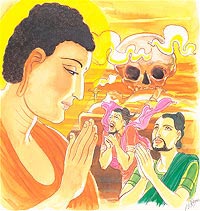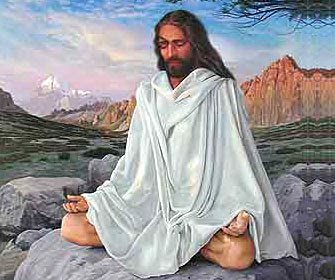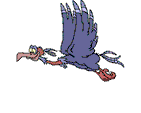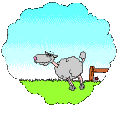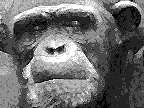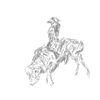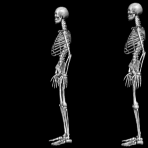20 06 2012 WEDNESDAY LESSON 643 FREE ONLINE eNālāndā Research And Practice UNIVERSITY And THE BUDDHISTONLINE GOOD NEWS LETTER by ABHIDHAMMA RAKKHITA through http://sarvajan.ambedkar.org
BSP stages walk out over power crisis in Uttar Pradesh-Buddhist Patanjali Yoga Practice animated-Criminals roam free in Akhilesh’s UP; jailed SP leaders get special treatment-Buddhist Patanjali Yoga Practice animated
Verse 212. The Outcome Of Endearment
From endearment grief is born,
from endearment fear,
one who is endearment-free
has no grief - how fear.
Explanation: From endearment arises sorrow. From endearment
fear arises. For one free of endearment, there is no sorrow. Therefore,
how can there be fear for such a person?
Dhammapada Verse 212
Annatarakutumbika VatthuPiyato jayati soko
piyato jayati bhayam
piyato vippamuttassa
natthi soko kuto bhayam.Verse 212: Affection begets sorrow, affection begets fear. For him who is
free from affection there is no sorrow; how can there be fear for him?
The Story of a Rich Householder
While residing at the Jetavana monastery, the Buddha uttered Verse (212) of
this book, with reference to a rich householder who had lost his son.Once, a householder was feeling very distressed over the death of his son. He
often went to the cemetery and wept there. Early one morning, the Buddha saw the
rich householder in his vision. So, taking a bhikkhu along with him, the Buddha
went to the house of that man. There, he asked the man why he was feeling so
unhappy. Then, the man related to the Buddha about the death of his son and
about the pain and sorrow he was suffering. To him the Buddha said, “My
disciple, death does not occur only in one place. All beings that are born must
die one day; indeed, life ends in death. You must ever be mindful of the fact
that life ends in death. Do not imagine that only your beloved son is subject to
death. Do not be so distressed or be so shaken. Sorrow and fear arise out of
affection.”Then the Buddha spoke in verse as follows:
Verse 212: Affection begets sorrow, affection begets
fear. For him who is free from affection there is no sorrow; how can
there be fear for him?
At the end of the discourse, the rich householder attained Sotapatti
Fruition.
With This Article An Indian Dark Age
of Ignorance Ends……….Parliament and Civics in Ashoka’s
EmpireBy
Hon. Dr. S.K. Biswas(From ASHOKA The Great* – Part II
of a long dissertation dispelling the Indian Dark Age of Ignorance about
their own history - first published in
Yug-Udbodhan (or ‘Dhamma’) periodical, New Delhi. The article was published in
four parts starting in July 1996, p12 and onward. (This periodical has ceased
publishing due to the demise of K.P.R. Bandhu, editor). (It is re-typed here by Chakradhar Hadke to reach a wider readership.)Part IIIEMPEROR ASHOKA THE GREAT
It is said
that power corrupts and absolute power corrupts absolutely. Monarchy does not
compromise with benevolence. It is also said that arrogance of power and not
the generosity of authority that emerges out of monarchy. But to the opposite, the
benevolence in the heart of Indian Emperor Ashoka the Great, a paramount ruler
of all he surveyed, knew no bounds. There are some European rulers, famous for
their benevolence. These monarchs were influenced by the democratic ideals of
Europe and were pressured to benevolence by the ever increasing power of the
people, whereas Emperor Ashoka’s benevolence sprang up from the humanity and
compassion within himself. So, when those grand regal, powerful personalities
of Europe are placed beside a Indian emperor so enlightened with the “Wisdom of
the Buddha”, one, namely “Ashoka the Great” and a comparative study is
attempted, their good names fade into insignificance along with their
benevolence, just as the stars in the night sky fade away with sun-rise.Buddhists
can claim, with some justification that these traits of character and of heart
of Ashoka were due to being submerged in the doctrines of the Gautam, The
Buddha from an early age.Impact of The Virtues of Kindness,
High Esteem And Love:The power at
Ashoka’s elbow was his united, purposeful family, his education and early
training and that the cardinal doctrines of Gautam, The Buddha, pervaded the
whole society; people could see and understand what he was doing. The emperor
won over the hearts of his fellow countrymen of the period and with these revelations
about his rule, for an eternity to come. This reputation was achieved by
implementing, or putting into practice some of the ideals spoken about by Gautam,The
Buddha; he made them a reality. What the Buddha preached, the emperor
practiced. He made the Buddhist ethos come alive for the people of his empire.This not
only affected the literacy and the domain of knowledge in the society, but it also
shaped the culture, religious practice, polity, politics and social interaction
of the common people of India (which included a great part of what we call
Afghanistan), as a whole. While on the one side of Buddhism there was the
concept of knowledge, the other side of the coin was the virtue of love and
belonging. Within the limitations of their environment, people could develop and
grow their talents, their personalities and character.This
benign rule encouraged feelings to arise of kind esteem, all people belong
together united, to overcome the problems of daily living. So, this sense of belonging
to one group in equality or oneness, emerged out of this kind esteem resulting
in a high degree group association and solidarity, an anathema to Brahmin and
Catholic rule. Note that without this feeling of all equal and united, inequality
occurs and the concept of equality for all is then never welcome by the more privileged.There are
some fundamental, but commonsensical forces at work here. On the one hand it has
been well demonstrated for millennia, that a society of un-equals (e.g.
Brahmins or Catholics) never had kind regards or high regards, for others of a
lesser standing: you can use them or abuse them. (Ref. the ‘Neo-Cons’ of the
USA!)On the
other hand, when thoughts of gentleness, kind esteem for society is held by
someone, there are no desires arising to go out and exploit others. Also, it
must be pointed out, the co-existence of love and untruth, or deception, is not
a normal phenomenon; you cannot hold your fellow men in high esteem but also
tell lies to them and then send them off to war, fought to suit your own
purposes.Holding up
an ideal as an example, the storm of love between lovers does not recognize any
caste or status barrier, because of the nature of love, neither is superior or
inferior. Lovers care for and protect each other, they respect each other. So,
having kind regards for others give rise to the sense of mutual respect and
well-being. Out of love can develop self-esteem, individualism, talent and
character.Social Contract Theory Of Gautam,
TheBuddha:Buddha
declared: “Sabbe Satta sudhi hantu, sabbe hantu chakhe mina”- let all beings be
happy and prosperous.His boundless
love taught: “Mata Jatha niyang puttand aayusa akaputtamanukakhe abampisabbe bhutesu
manasambhabayeparimanang”- as the mother gets ready to sacrifice her own life
to save the life of her only son, so also, one is to love every being”.These are
high-minded principles. In society each one is to love, respect and care for
the other one; everyone should work for the good of the majority and for the
happiness of the majority; “Bahujana hitaya Bahujan Sukhaya”, preached Gautam,
The Buddha and these ideals were practiced in reality and even transformed into
state laws by Emperor Ashoka.Therefore,
when Buddha, preached the theory of kingship, it was mostly with the concept of
love and respect for every individual and he propounded the doctrine of “Social
Contract Theory”. It was impossible for Gautam, The Buddha, who had kind
compassion for all, and who wanted welfare for all, to hold and propagate a
theory of divine kingship, which makes the potentates assume absolute powers, on
authority deriving from GOD, a generator of arrogance of power, overweening pride,
and thereby becoming a machine for exploitation of the weak. This “divine right”
– God given right to rule, to kingship, runs contra to the Buddha’s doctrine of
the “Social Welfare State.”People
generally believe that the “Social Contract Theory” of kingship was, for the
first time in the world, given by the French revolutionary political
philosopher, Rousseau during the 18th Century CE. From a historical standpoint
it was, however, not correct; it was Gautam, The Buddha who was first to propagate
the “Social Contract Theory” more than 2500 years ago. And Emperor Ashoka was
the first ruler on the earth who put the theory into practice during the 3rd
Century B.C.E. He did this deliberately
as a Buddhist policy.The
Buddha’s theory has been recorded elaborately in the “Agnagna Sutta” of the DighaNikaya.
Buddha described the process of emergence of the private property in the human
society. Eventually, the unbridled desire to accumulate private property (greed)
gave birth to all kinds of corruption (- unacceptable lust and hate) and
criminal problems. Usually, the leader of military conquest, the strong-man,
became king and absolute ruler. His children, without such mighty power and
authority had to rely on GOD for support.
Thus there arose the institution of the divine right of kings. So in the
Dighanikaya, The Buddha gave us “ Then all the crowd shouted to a Satta (man) …..
then others caught him and spoke; “O satta (man) you have done wrong, don’t do
it again”….. and a second time they did this … and a third time they did this,
and then the crowd told the Satta (man), “ You have done wrong things ….” Finally, when it was done again, he was caught
by the crowd and beaten up. From then on for theft, lies, and other offences
against others, etc., condemnation and punishment was prescribed….Then all
the Sattas ‘beings” assembled together and decided there has arisen corruption
amongst us.. now let us elect someone who will condemn the corrupt and punish
the guilty, praise and reward the praise worthy, who will prescribe every one’s
duty and proper function and banish the ones who will be so deserving……… Then
all went and approached the most mighty and bright personality of the clan and
requested him: “O Satta! You give us the verdict of just and unjust actions,
condemn the guilty, and banish the ones who deserve so. We will give you share
of our “Shali.” He accepted the offer by declaring, “Be it so.” He became known
as “Mahasammata” as he was agreeable to the request of the Mahajans, the
people’s request.”Emperor
Ashoka, although a paramount and absolute ruler, shaped his life style as well
as his royal office as the embodiment of this theory of social contract. He did
not rule his kingdom and his subjects remotely, he was deeply involved. He had
secretaries who informed him, and he would act at any time or place. To this
effect the Emperor declared and have recorded: “ A long period has
elapsed during which in the past business was not carried on or information
brought in, at all times. So the arrangement has been made that at all times
when I am eating, or in my private room, or in the news, or in my conveyance,
or in the pleasure-grounds, everywhere the persons appointed to give
information should keep me informed about the affairs of the people……….……….
Because I never feel satisfaction in my exertions and dispatch of business.
For, work I must for the welfare of all the folk; and of that again, the root
is energy and dispatch (speedy) business; for nothing is more essential than
the welfare of all the folk. And whatsoever efforts I make they are made that I
may attain release from my debt to animate beings, so that while in this world
I make some persons happy, they may win heaven in the world beyond. For that
purpose have I caused this scripture of the Law to be written in order that it
may endure, while my sons, grandsons, and great-grandsons may take action
for the welfare of all folk. That, however is difficult save by the utmost
exertion.”No
absolute monarch who ascended the imperial throne on the basis of hereditary
right, or as a natural heir to it, in the world, felt while discharging his
official duty or doing welfare of his subjects, that he was liquidating some,
“debt to animate being (subjects or otherwise)” and realized that attainment of
release from the dept comes through tireless services to the animate beings.
These, as a natural corollary, come out of the teachings of the “Social
Contract Theory.” Ashoka mounted to the throne of the Indian empire not through
a democratic election, but by war and the suffering of his subjects. Even with
absolute power he recognized the greater goodness and power of The Buddha’s
teachings and so became a benevolent ruler.
Embodiment of the Parent:Ashoka’s
head was filled with the milk of human kindness that a mother posses for her
only son as taught by Gautam, The Buddha. He made efforts to care and develop his
subjects with personal love and affection. All rulers are obliged to appoint
Governors, Viceroys, officers and feudal lords to consolidate, collect revenue
and to rule the land and its people under his governance. But Emperor Ashoka
was unique, one who engaged provincial governors to look after the subjects as
the parents appoint good nurses for the children. He declared this by the
imperishable method of writing rock edicts.“To my
Governors set to govern over many hundred thousands of people I have granted them
powers, confidently and fearlessly so they may perform their duties, and bestow
welfare and happiness upon them.They will
ascertain the causes of happiness or discontent and through the subordinate
officials of the Law of Piety will exhort the people of the country so that
they may gain in both this world and the next.My
Governors, too, eager to serve me; my Agents, also, acknowledging my will,
shall serve me, and they, too, on occasion, will give exhortations so that the
Governors will be eager to win me.For, just
as a man having made over his child to a skillful nurse, feels confident and
says to himself, “The skillful nurse is eager to care for the happiness of my
child,” even so my Governors have been created for the welfare and happiness of
the country, with intent that fearlessly, confidently, and quietly they may
perform their duties. For the reason I have granted to my Governors
independence in the award of honours and penalties.”The Rule of Law:The last
paragraphs of the Rock Edict No. IV, reveals a starting point regarding the
existence of the “Rule of Law” in ancient India. The Hindu society of later age
and the Brahminical society of the pre-Gautama period basically had been lawless
and without any institutions worth the name ‘judiciary’. The corrupt rule of
the Aryans, made up the rules on the principle of favoring themselves and discriminating
against the lower classes. These were called caste-laws; the duty of the Brahmin
kings were primarily to observe and maintain this law of “ChaturVarna and Ashrama.”
These laws were in practice some sort of ‘divine right to robbery,’ ‘divine
right to cheat,’ ‘divine right to loot,’ and ‘divine right to murder, ’ etc. , in
those cases committed by the Aryan Devatas. There was nothing criminal for the
Brahmins. They enjoyed total immunity from laws. The Laws of Manu, etc., give
evidence to this position.While the
French traveler Barnier wrote his famous account, “Travels in the Mughal
Empire” in the closing years of the 18th Century he recorded, “There
is no one before whom the injured peasant, artisans, or tradesmen can pour out
his just complaints, no great Lords of Parliament or judges of local Courts,
exists as in France, to restrain the wickedness of those who oppresso, and the
Kadis, are not invested with sufficient power to redress the wrongs of these
unhappy people” (p-225).But India
was not always a lawless country, a country of divine but corrupt Brahmin
classes. Indeed, 2300 years ago, from today, the teachings of the Buddha, the
pearl without price, enlightened and strengthened the might of the character of
the emperor Ashoka to promulgate the laws, impartial and uniform and set up a
Judiciary on the basis of “Rule of Law.” He did not care about the
consequential, Brahminical reaction, one of conspiracy-prone antagonism.
Nothing daunted, the emperor declared. “Vaybhara Samata Danda Sama” equal
punishment for the equal offence, irrespective of the offender’s caste, creed
or status, He recorded:“For as
much as it is desirable that there should be uniformity in judicial procedure
and uniformity in penalties, for this time forward my rule is this:–“To
condemned men lying in prison under sentence of death a respite of three days
is granted by me.” (Edict-IV)Not just for
human being, Ashoka arranged for the happiness and comfort of the beasts and
birds too. His ever vigilant paternal eyes looked into the happiness of all
being. This could have only been possible because of the magic-call of the Lord
Buddha: “Sabba Satta Sukhi Hantu, Sabbe hantu Chakhe Mina”. Let all being be
happy, let all be prosperous. That he transformed Buddha’s ideals into practice
has been documented into the rock edict, in an auto bioraphic form: “ On the
roads, too, I have banyan-trees planted to give shade to man and beast; groves
(or “gardens”) of mango-trees. I have planted; at every half league I have
wells dug; rest-houses, too, have been created; and numerous watering
places have been provided by me here and there for the enjoyment of man and
beast.A small
matter, however, is that so-called enjoyment. With various blessing has mankind
been blessed by former kings, as by me also; however, with the intent that men
may conform to the Law of Piety, has it been done even as I thought.”Secularism: Most AncientEmperor
Ashoka’s boundless grace became transcendent in society. Like Lord Buddha, he
also brought members of different religious sets and creeds, clans and races
under has protective umbrella of love and compassion. Buddha was the deliverer
of the suffering humanity, the helpless, sad-stained beings. He was against the
Brahmin discriminators who coerced and exploited human beings in an
unspeakable, demonist manner. He declared the majority of the population,
Sudras or Untouchables, as fully equal to all. Despite that he allowed all
the arrogant earthly gods whosoever, to beg for his compassion, favor, mercy
and grace. So also Ashoka embraced all irrespective of caste or creed. He
declared in one of his edicts:“My
Censors or “High Officers” of the Law of Piety, too are employed on the manifold
objectives of the Royal Favor affecting both ascetics and householders, and are
likewise employed among all denominations. They are employed on Buddhist
business, too, as well as among the Brahmins and Jains. Similarly, they are
employed among the miscellaneous sects of Jains, too.”There were
five main religious sects at the time of Emperor Ashoka, those were: Buddhists,
Ajivikas, Nirgranthis, Brahmins and Jains. There were also some other minor
sects. Ashoka the great though himself a Buddhist, never treated the other
sects with disfavor from the official angle. The principal of secularism was
pronounced by a state head, for the first time in the world when Ashoka
declared:“His Sacred
and Gracious Majesty the King does reverence to men of all sects, whether
ascetics or householders … the too of it is restraint of speech, to wit, a man
must not do reverence to his own sect and disparage that of another without good
reason. Depreciation should be for specific reasons only, because the sects of
other people all deserve reverence for one reason or the other.By thus
acting a man exalts his own sects, and at the same time does service to the
sects of other people. By acting contrariwise a man hurts his own sects, and
does disservice to the sects of other people…”Parliamentary Democracy:Emperor
Ashoka had a regal personality: stern and alert like a father, while his heart
was soft with the tender feelings of a mother. Ashoka behaved like a very
practical man as he implemented the cardinal philosophy of the Buddha.Gautam,
the Buddha did not in the speculative philosophy of metaphysics. Buddha
declared that there was no God. He led all humanity to the path of self
realization, reasoning and rationality in the search for what was good and true
and what was not. “Atta deepa bhava” (You are the architect of your own
destiny) was his call. A person will suffer or be happy according to his own thoughts
words and deeds – Buddhist Kamma. Since there was no chance of getting an extra
bonus from intervention by any supernatural power like God to achieve a target,
human power had to exert and excel on its own merit. Therefore, Emperor Ashoka
declared, “A great virtue is to be always active.” Knowledge, experience and
training and the practice of virtue in this mundane earth, were the teaching of
Law of Piety that Ashoka preached. Ashoka the Great, thus, stands as the father
of individualism. The point of equilibrium of individualism and State authority
is the basic point of social-justice and democratic life of human beings. Ashoka even appointed a team, a
Council of Ministers with specific portfolios and power. He seems to have
brought into practice a system of parliamentary democracy with the parental
patronage of the Emperor – very likely mostly his brothers who had been his
army generals! As in case of Great Britain, the parliamentary form of democracy
runs along with the institution of kingship intact (But needs the Monarch’s
approval for any deployment of troops!). As Dr. Ambedkar spoke: “A study of the
Buddhist Bhikhu Sangha reveals that not only were there Parliaments—for the
Sangha meetings were nothing but a Parliament – but the Sangha meetings
employed all the rules of parliamentary procedure known in modern times. They
had rules regarding Motions, Resolutions, forming a Quorum, Whips to ensure
voting, Voting by Ballot and Counting of Votes, Censure Motion, Regularization,
Resolutions, Judicature, etc. Although these rules of Parliamentary procedure
were applied by the Buddha to the meetings of the Sangha, he must have borrowed
them from the rules of political assemblies functioning in the country in his
time.”Emperor Ashoka
employed these parliamentary procedures his machinery of government. In this
context it is interesting to note that whatever principles available in the
preamble of the Constitution of modern India were current procedures in the
government of Ashoka.(To be
continued ………. In next part IV….)
With This Article An Indian Dark Age
of Ignorance Ends……….Education And
Learning In Ashoka’s EmpireBy
Hon. Dr. S.K. Biswas(From ASHOKA The Great* – Part II
of a long dissertation dispelling the Indian Dark Age of Ignorance about
their own history - first published in
Yug-Udbodhan (or ‘Dhamma’) periodical, New Delhi. The article was published in
four parts starting in July 1996, p12 and onward. (This periodical has ceased
publishing due to the demise of K.P.R. Bandhu, editor). (It is re-typed here by Chakradhar Hadke to reach a wider readership.)History of Script and LanguageThe
inscriptions found on Emperor Ashoka’s pillars and his rock edicts shine a
bright light on to the wide-spread literacy of Indian society, on the state of
development of scripts, languages and literature of the India of about 2,300
years ago. Sadly however, today’s India has the largest illiterate population
of this world.But it was
not like that in the Ashokan era. Generally people had some education and they
were in a position to read and write; they were literate. Had the condition of
mass literacy not prevailed, the emperor would not have taken pains to
record his instructions in public places of mass gatherings, on the road side,
in commercial complexes, at places of pilgrimage and even in the remotest
places of his Empire. The general public was literate, certainly - or else the
pious but expensive effort of cutting out and polishing pillars and leveling rocks
just to inscribe messages in the vernacular language concerning morals, etc.,
by the Emperor would have been a futile exercise. The creation of these edicts
only becomes meaningful if the people were literate. Buddhism is a religion
requiring knowledge and reasoning. Buddhism made the fruit of knowledge available
for all and education is the cardinal rule for spiritual attainment. Thus they
declared: “Satyam Eba Joyate” - the finest of the followers of this faith.Siddhartha
Gautam achieved Bodhi or awakening to this world only after acquiring a good
education, himself. As an ardent and democratic minded follower of Buddhism,
the educated Ashoka was bound to promote universal education, too.But in
contrast, the God-based religions restrict or even deny education to the people
in their grip. (That is why the first universities in Europe were started only
around 1364CE! – 1600years AFTER Buddhist centres of learning were started. ) The
Holy Bible threatens Adam and Eve with ‘sure death’ if they ever ate the fruit
from the Tree of Knowledge. It was
therefore, a great and risky chance they took to defy the threat of “sure
death,” to defy the words of the Lord God just to get knowledge which would
enlighten them to know and distinguish between good and bad. Gracious was the
Lord God who, in his great wisdom and mercy, did not punish Adam with “sure
death.”And in Brahmanism, it is the same story for those
living under their rule - the Sudras, Vaisyas and commoners were all denied
their right to education and knowledge. Hinduism never allowed the common
people to have the fruits from the Tree of Knowledge.In
comparison, benign Ashoka established public schools, colleges and universities.
All the Buddhist monasteries operating in his empire were establishments of
learning, too. Pre-eminently, Buddhism is the religion of learning, discussion
and rational debate; it is the road to Wisdom out of ignorance, faith and
dependence.Sanskrit, Pali, Prakrit, and Indian
Native LanguagesSanskrit
was made the prerogative of the spiritual leaders of Brahmanism. It was the exclusive
language of the elite. This enabled them to create a blanket of ignorance for
the many, lasting over the recent millennia. (- just as for the long ‘Dark Ages’
of Europe!)In
contrast, Buddhism requires its followers to have education. Gautama of the
Sakya clan, the Buddha, used Pali and Prakrit, that is, the local vernacular
languages or dialects of contemporary India, while preaching his Dhamma. The
Buddha was obliged to reach out to people in their own language – or fail. Similarly, three centuries later, Ashoka had
to use a language in his Edicts that people could read and understand.Pali and
Prakrit were the aboriginal forms of language of ancient India. These were the
linguafranca of the entire northern India. Other languages like Sanskrit, etc,
and modern languages like Bengali, Oria, Assamese, Bhojpuri, Moitheli, Hindi,
Punjabi were born out of these Pali and Prakrit languages. Sanskrit was never a
lingua franca of the Indian people -it was a language used by the community of Brahmins
for other Bhramins only. Others were not free even to learn this language. (As
a result, according to the 1951 census Sanskrit was the mother tongue of only
555 Indians; this figure increased to 1,284 as per the 1971 Census. This being
the case, it will be misnomer to call Sanskrit a language. It is a communal
dialect.)The script
used in the Ashokan Edicts, when discovered, came as a surprise to the British
Colonists but came as a huge surprise to the Indian scholars and historians.
These scripts were unknown to the Indian scholars! It was definitely a matter
of the greatest shame that all traces of these scripts had been lost, unknown, to
the autochthons, the natives of India. The Brahmins were so successful in their
attempts to obliterate Buddhism and its associated historical events, that when
centuries after, the Europeans discovered these edicts, there was no Indian to
recognize even his own language!Imagine! To
produce this condition of total national blackout, a terrible torrential flood
of devastating destruction must have passed over the nation, the true nature of
which can be only remotely guessed at. The material aspect of a past
civilization can be destroyed with some diligence and effort; and it can be
replaced with another, but traces remain – e.g., the silhouette outlines of the
Bamiyan Statues. But here we are dealing with a complete black-out of a
thousand years of Indian Buddhism and its history and culture, akin to a
blanket of lava laid over their past by the savage Aryan intruders.Eventually,
the scripts were deciphered by European scholars who named them Brahmi and
Kharosti scripts. Some examples are written from right to left. These scripts
opened up the flood gates of truth regarding the origin of Devanagari
and other scripts that are used in the Indian language.Before the
discovery of these scripts, Indian philologists thought that the origin of the India
scripts were the Phoenician scripts which were developed and used by the
mercantile community of the ancient city-states of Babylon, Sydon, Tyre, etc.,
located on the eastern bank of Mediterranean Seas of old Caanan after 2500 BCE.
But the
discovery of the Ashokan scripts, the earliest available form of scripts in
India, declared in no uncertain terms that these scripts were the relatives of
the Indus Valley scripts which were used by the pre-Aryan indigenous Indians
going back to 2000 BCE. And not any old foreign school of script but the
Assura-scripts of the Indus Valley which are the mother of all scripts used in
India.Let us
record, here, some expert views on this issue: Acharya Sunit Kumar
Chattopadhaya opines:“When
European scholars first tackled Brahmi, they gradually formed the opinion that
it was a derivative ultimately of the ancient Phoenician alphabet of about 1200
BCE which came either in a northern form directly into India, or in a southern
form as it had developed in Southern Arabia. It was suggested by them that
there was no system of writing known to ancient Indians, whether Aryan or
pre-Aryan, and that Indian merchants who went for trade to Mesopotamia and
South Arabia got the idea of writing of Prakrit dialects and Sanskrit, and this
could have only taken place by 500 BCE, giving us finally the finished Brahmin
alphabet of the Maura times. A certain similarity between the shapes of the
Brahmi letters and those of the oldest Phoenician alphabet, both standing for
the same or similar sounds, gave considerable support to this theory.But the
discovery of the Mohenjodaro writing has called for a revision of the view that
India was indebted to the Semitic world for her script. It has been found that
quite a number of symbols occurring in the Mohenjodaro writings have
resemblance to the letters of the Brahmi alphabet. Moreover, the Brahmin
consonant letters seems also to have been in use in the Mohenjodaro script. We
can distinguish several stages in the evolution of this ancient, prehistoric
Sind-Punjab writing, a pictorial and hieroglyphic, a syllabic, and then a much
more simplified linear form which was probably alphabetical.It is highly
probable that the Brahmi alphabet was just a modification of the Sind-Punjab
script, and which was in widespread use before the Aryans arrived. They
probably had no system of writing of their own, although they had occasion to
come in touch with this great envision of civilization in Asia Minor and
Mesopotamia. After they settled down on the soil of India, a modified form of
the late Sind-Punjab script was in all likelihood adopted to write the Aryan
language, which was at that time a kind of late Vedic Sanskrit. This adoption
would appear to have taken place by 1000 bce., which alone made possible
the compilation of the mass of Vedic literature, so long current orally, into
four written compilations, the four Vedas which Krishna Dwaipayana Vyasa is
traditionally held to have composed. Vyasa was an older contemporary of the
heroes of the Mahabharata, and the Mahabharata drama, according to Pargiter and
H.C. Raychaudhary, (who followed quite different methods in working out the
date), took place in the middle of the tenth century BCE. So that we would not
be far wrong in assuming that this became the finished Brahmi of 300 BCE.
Even in Mauryan Brahmi, we find the script still hesitating in certain matters
and not fully established as a system of writing, it did not know how to
indicate properly double and conjunct consonants. The perfection of the Brahmin
alphabet as a worthy competitor for Sanskrit with its scientific and accurate
orthography would appear to have taken place as late as the early centuries of
the Christian era.”Genesis of Brahmi is the Indus -
LanguageEven prior
to the discovery of the Indus scripts many historians could trace out the fact
that Indians were highly literate and they had their own scripts and written
language and dialects. General Cunningham opined on the issue:“In this
brief examination of the letters of the old India alphabet, I have compared
their forms at the time of Ashoka, or 250 BCE with the pictures of various
objects and it is my conviction that many of the characters still preserved,
even in their simpler alphabetical forms, retain very strong and marked traces
of their pictorial origin. My comparison of the symbols with the Egyptian
hieroglyphics shows that many of them are almost identical presentations of the
same objects. But as the Indian symbols have totally different values imbued from
those of Egypt, it seems almost certain that the Indians must have worked out
their system quite independently, although they followed the same process. They
did not, therefore, borrow their alphabet from the Egyptians.“Now, if
the Indians did not borrow their alphabets from the Egyptians, it must have
been the creation of the people, locally themselves, for the simple reason that
there was no other source or people from whom they could have obtained it.
Their nearest neighbors were the people of Anana and Persia, of whom the former
used a Semitic character alphabet of Phoenician origin, reading from the
separate detached strokes, which has nothing whatever in common with the
compact form of the Indian alphabet.”It is now
very interesting that before the discovery of the Indus-scripts, in 1921, what
was a mere speculative opinion for Cunningham, became an authentic and proven
historical fact for Dr. Suniti Kumar Chattopadhyaya. On the basis of the
archaeological and circumstantial evidences Chattopadhyaya has indicated that
the Indus scripts were the mother of all the schools of scripts used in India
even in the modern period. And this course of change or development (primarily
artificial) could not have been tracked down in the absence of the Ashoka
scripts (used on the Edicts), which stands at the middle path or as the first
stage of change or shift from the original form to the final stage of its
transition.Dr. Chattopadhyaya
has also very rightly commented that the Aryans had no script or modality to
record their ideas and communiqués. That is why they did not bring any
documentary evidence along with them at the time of their arrival in India. No,
they could not produce any written document, soon after subduing Assura of
India. That is why it took around a thousand years for them to learn the India
mode of writing, the scripts and language. It took so much time because for the
first few centuries they spent their time destroying all marks and traces of
literacy of the pre-Aryan Assura people or to artificially transform them into
different shapes so that in posterity, the sons of this soil could not
recognize and understand their ancestral language! And that is what really
happened. No Indian could, therefore, recognize or read the Ashokan language or
scripts. Nobody knew about the Pali language or scripts. Nobody knew about the
Pali language which had an enormous volume of literature, older and more
voluminous than Sanskrit literature.Aboriginals Use Indus-Scripts TodayFrom
philological stand point, it is understandable that the language used by a
minority foreigners does not survive for long in an alien land, and in the
midst of a hostile atmosphere. In our case, the foreign Aryan language which
was an unwritten one, was bound to be merged and mingled into the ocean of
advanced and written language existing in the pre-Aryan highly civilized era of
cultured Indians. This is why, even the more developed English and the
Arabic-Urdu language which had its written form of literature, failed to
replace any of the Indian languages, like Tamil, Telgu, Malayalam etc. It is in
the circumstances, reasonable to conclude that the unwritten language of the
savage, pastoral Aryans was annihilated by the written Indian language.In the
circumstances, it is interesting to note the Sindh-Punjab aboriginal scripts
have been found in the area of the Bengal-Bihar border also. The Bihar
Transport officer N.K. Varma, claimed to have deciphered the script, discovered
in the archaeological ruins of pre-Aryan Indian Assura civilization of the Mohejodaro
Harappa region. To his great surprise, he found the Santhals (tribe) to have
used the Indus scripts by the Santhals of Sahib Ganj. This opens up a flood
gate of suppressed truth that some autochthons of India, sitting 3000 Kms. away
and 3000 year’s dark distance away in time, are using the aboriginal scripts
even to this day.Plagiarised by the AryansHaving
made a comparative study of the vocabulary of the Vedic texts and the Ashokan
edicts, along with the language of the Santhals of Sahib Ganj on the
Bengal-Bihar border, we have been able to remove the veil and can see a clear
picture of the native language of India. It is obvious that the Aryans not only
grabbed the scripts of native Indians, as has been suggested by Dr. Suniti
Kumar Chattopadhyaya, but they also plagiarized (copied) the language and
vocabulary of the natives of India. The victorious Aryans, simply gave some
artificial twists in the pronunciation and spelling to the structure.What
N.K.Varma has deciphered in the Indus script, on the basis of the symbols, used
by the Santhals of Sahib Ganj is revealing. “They use symbols akin to Indus
inscription in their writings and songs known as verses of “Karm Bintee”
describe a beautiful land of seven rivers, “Eay Nay Daishm” “Dag Gorhan” as to
denote writing. Some other tribal words as deciphered by Varma are:
“Nayke-priest; Eay-seven; Nai-river; Daishm-land or country; O Rab—O God;
Gooi—cow; Kaskom—cotton; Abharan—dress or cloth,” etc. If we analyse further we
find that these words mentioned above, as used by one of the famous autochtrons
(native) groups, are very familiar to us, such as:- Pooja; Khond (Kar) Karma;
Bintee; Dag (line_ Grohan (take or make); Nayak, Sat; Nadi; Desh; Gaai; Abharan
(Sanskrit). In some form they exist in the Vedic language.All of
these words are available in the Pali language too. If we analyze the Ashokan
inscriptions we find the words are Pali and they form the vocabulary of the
early Vedic language too. Let us take some examples: “Sayameba Joyate”, Sab
Munispaja Mamaa”; or “Asu putra prapoutra Me navam Vjiyam Ma Vijityavam” etc.,
as has been written by the Emperor Ashoka the Great in his inscriptions. The
word “Satyadharma” has been used in the Rig Veda as an adjective of a native
Indian called, Agni, the son of Bala Assure; the word “Joy” is abundantly
available, the word “Munish” in the Rig Veda denotes common village – subjects,
artisans or peasants. The word “ Muni” -the saint exists in the Vedas, “Sab”
denotes Sarba; “Paja” denotes praja; “Mama” denotes Mama. The words “Putra”,
“Prapoutra”, “Bavam” “vijoy” etc. are frequently used in the early Vedic and
Sanskrit language with the same meaning.Similarly,
we may find traces of most of the Vedic-cum-Sanskrit words in the common tongue
of the remote illiterate villagers who does not know anything of the Sanskrit
language. India villagers of upper India generally used the word “piba” for
expressing the verb “drink”. The word “pani” (water) appears to have come from
the “pani” (the Bank of businessmen who used to sail across the seas during the
pre-Aryan period). The very familiar word of today, “pannya-drabya” meaning commodities
is derived from the word “pani”. The Aryans had neither mercantile people, nor
slaves or dasa with them, while, the word Dasa and the servile classes was very
familiar in the pre-Aryan India. The word “das” has been taken by the Aryans
from an Indian source. Likewise most of the words in the Vedic language are
available in the Ashokan-pali language, in the use of the Santhals and these
are taken from its original source in the pre-Aryan Indian language and
literature.This
situation is corroborated by the fact that the number of people with Sanskrit
as their mother tongue is only 555 and 1284 as per the Census Reports of 1951
and 1971 respectively. The Aryans have never been reported to be a barren race.
They have never suffered any massacres, etc. The orthodox Aryans are not
reported to have deserted their mother tongue at any point of time. Despite
this, the number of people with Sunskrit as their mother-tongue was so few
simply because it was never their mother tongue. This was a language as
developed artificially from the native language of India. They very fondly
called this language “Sanskrit” - that was purified from some dirty, impure-ore
language. The Aryan Brahmins thus not only condemned the common people of India
as low, but also made out that the language they spoke was impure and polluted.The
Ashokan inscriptions show that the linguafranca of at least the Northern India,
from the Himalaya to Vindya mountains, and from the Indus to the Ganges was
this Pali-Prakrit language with its varying dialects. General Cunningham calls
them the Punjabi, the Ujjaini, and Magadhi. This was a very normal phenomenon
which resulted from the country’s vastness. The Ujjain dialect is marked by the
entire absence of “R” for which “L” has been substituted: e.g., Laja for Raja,
Dasalatha for Dasaratha, etc.The
tangible evidence provided by the Ashokan script, the scripts of Indus nature,
which were available in the Indus valley, has shown us a bridge between the
modern Santhals writing and its genesis, as used in the Mohenjodaro-Harappa
writings. Without finding the Ashokan scripts it would not have been possible
for us to explain the missing-links of current languages and scripts of the
country. From these edicts, it is easy to deduce that the Aryans destroyed the
aboriginal Indian language in the course of the first takeover battles that
they fought in this land to destroy Buddhism. Language is the preserver of the
cultural and religious heritage. It is the scripts, language and literature
which records the ideals and ideology of a civilized race so that their
posterity can use it and can derive benefit from it. Therefore, to destroy all
the evidences of the religious ideals of pre-Aryan India, the prevailing
Buddhism of the Indus regions the Aryans annihilated our scripts, language and
literature.(Part III
will be continued within some days…….)Compiled,
Preserved and Propagated byAyu.
C.C.HADKE
Old Bangladesh – A Buddhist StrongholdBy D P Barua, Secretary-General of Asian Buddhist Conference for Peace (ABCP)
http://peacejournalism.com/ReadArticle.asp?ArticleID=6005“… this epoch of Buddhism created a rich culture and
civilisation in Bangladesh from the Eighth to Thirteenth Centuries. The
teachings of compassion, harmlessness and harmony of the Buddha, again removed oppression
and discrimination among men in the society and generated a new spirit of
equality, fraternity and humanity. During this reign of the Pala kings there
was a movement against caste discrimination. … …
… … The final disappearance of Buddhism in ancient Bangladesh is
mainly attributed to the degeneration of Buddhism into obscure Tantric cults
and also emergence of religious and social conservatism in the subsequent Sena
Rule. At that declining stage of Buddhism, the Senas who supported Brahminical
doctrines, came from south India and destroyed the social structure founded on
equality of all people in the Pala Age. A sizeable number of Buddhist monks
fled to Nepal and Tibet with their manuscripts and religious books while some
others continued their existence here under various camouflages. … “———————In fact Buddhism was the first and the
foremost religion of Bangladesh for more than a thousand years. It made a deep
impact on Bengali culture and civilisation through-out those centuries. Bangladeshi
Buddhists fondly maintain the tantalizing thought that this god-like man of
this world - the Buddha, actually visited Bengal and taught his Dhamma. Historians,
however, do not find authentic proof that he visited this region. In any case it
is known that Buddhism reached ancient Bangladesh shortly after his passing
away.Emperor Asoka was the greatest benefactor and supporter of Buddhism in all of its
history. Asoka’s ascension to power took place 218 years after the Buddha’s
passing away. Under his royal patronage he initiated a remarkable period when
the wisdom of the Buddha took root in the soil of the entire Indian
sub-continent. For example, he built Buddhist monasteries (called Viharas) and built
84,000 Stupas or monuments throughout India. He even inscribed the Buddha-
Dhamma (Wisdom) on rock edicts, and rocks found in hills and mountains. These have
endured the ravages of time and still exist today. His missionary monks went to
lands in all points of the compass and preached the Dhamma: in Sri Lanka to the
south, Afghanistan, Egypt and some other countries to the west, Siam (Thailand)
and Burma (Myanmar) to south-east.Chinese pilgrim Fa Hien (359-415ce) during
his visit to India in the Fifth Century came to ancient Bengal and found
Buddhism in a flourishing condition due to the impact of Asoka’s religious
missionaries. In the Seventh Century, the most outstanding traveller-pilgrim,
Hieun Tsang toured India for 16 years from 629 to 645 AD. While touring ancient
Bengal he noted that people followed the Buddha-Dhamma in Mahastan, the chief
city of Northern Bangladesh and in the city of Pundravardan, too. He visited the
Samatata region in 639 AD in present-day Comilla and recorded in his travel
diary as having seen 30 Sangharams or monasteries here inhabited by 2000 monks
of the Thervada school.In fact, the Wisdom of the Buddha, the Dhamma, was the original and basic religion
and inculcated a gracious, cultured way of life for Bangladeshis for more than
2000 years. It had taken root and created a deep impact on all Bengali life,
culture and civilisation throughout the centuries, even in the midst of the rise
and fall of Bangladeshi dynasties and kingdoms. The names of two devotees from
Bengal; Dharmadatta and Rishinandan of Pundravardhan are inscribed in the stone
entrance gate of Sanchi Stupa, constructed during Emperor Asoka’s reign. The
name ‘Banga’ also appears in the stone inscription of Nagarjunikonda dated
Fourth Century BC.From the Fourth Century AD the Gupta kings of ancient Bengal who professed
Hinduism and the Vaisnava cult, showed exemplary tolerance to Buddhism. Fa Hien
in his travel diary during Gupta rule wrote that Buddhism and Hinduism
coexisted in an atmosphere of peace and tolerance. The Gupta period was marked
in Bengali history for remarkable excellence in religion, philosophy,
literature, poetry, sculpture and paintings.In the Seventh Century, Bhikkhu Shilabhadra, born in present-day Comilla became
The arrival
a most outstanding monk. He was appointed as Principal of the biggest university
of the world, the famed University of Nalanda. Hieun Tsang studied Yogashastra
under him for two years and paid glowing tributes to his Master as the most
profound scholar and philosopher of ancient India. Acharya Chandragomin of this
period, too, was known as an outstanding grammarian who wrote grammar further
developing and enhancing the traditional Sanskrit vocabulary of Panini.
of a period of anarchyThe seventh century in ancient Bangladesh
was marked by a period of total social anarchy and lawlessness causing feuds
among sections of the people. This period lasted for more than half a century, and
is described as ‘Matsyanyaya’ which means big fishes eating small fishes,
implying oppression of the weak by the strong. After enduring these circumstances
for so long, in the eighth century the people elected a local chieftain named
Gopala to rule. King Gopala founded and initiated the Pala Dynasty. He was a
practicing Buddhist and created a new social order based on justice and
equality among all people. Nearly 400 years of the Pala Rule (850-1250)
witnessed the renewal and rejuvenation of Buddhist civilization in Bangladesh.King Gopala established Buddhist monasteries in different parts of the country.
The famous Buddhist Philosopher, Acharya Santarakhshit, visited Tibet and
stayed there untill 762 AD studying methods and means for the reformation and
regeneration of Buddhism. He is known as ‘Pandita Bodhisattva’ in Tibet. The
Second Pala Emperor, Dharmapala was the founder of our renowned, and famous ‘Prajnaparamita
Sutra’ of Buddhism. He constructed 50 monasteries and founded the famous
Vikramshila Vihara and Sompuri Vihara.This epoch of Buddhist practice (Buddhism) created a rich culture and
civilisation in Bangladesh from the Eighth to Thirteenth Centuries. The
teachings of compassion, harmlessness and harmony of the Buddha, again removed
power and discrimination among men in the society and generated a new spirit of
equality, fraternity and humanism. During this reign of the Pala kings there
was a movement against caste discrimination. Poet Sarahapad composed songs and
poems against the wickedness of the caste system. Quoting Gautama Buddha’s
teachings, a poem said : ‘If among the Brahmins, some engaged themselves in
education and learning and led pure lives and if some others are engaged in
killing and theft, how can these two types of Brahmins be placed in the same
category as equals?’Buddhism emerged as the dominant religion of the masses and exercised profound
influence on the social, cultural and intellectual lives of the people. During
this period big monasteries like Vikramshila, Somapuri, Agrapuri, Kanakastupa,
Jagaddala, Odantapuri, etc, flourished as Buddhist centres of learning as well
as teaching secular arts and sciences. The most significant of these
monasteries was Sompuri Vihara whose massive ruins had been unearthed at
Paharpur of Rajshahi district in northern part of Bangladesh by British
archeologists. Unique in ancient temple architecture, this Mahavihara developed
during the Pala Dynasty from the Eighth to Eleventh Centuries and is described
as the biggest monument to Buddhist learning south of the Himalayas. The
architecture of this Vihara has influenced the style of monasteries in South
East Asia up to Indonesia where the monumental Borobudhur Temple of Java has
been modelled after it. Archaeological excavations at Mainamati in the Comilla
district led to the discovery of Salvana Vihara which constitutes the ruins of
the historic Kanakastupa Vihara as witnessed by Hieun Tsang.One of the greatest centres of Buddhism in the sub-continent after the decline
of Nalanda was Pandita Vihara located somewhere in Chittagong as the major
establishment of the Tantric Mahayana school. Atish Dipankar Srijanan, the
outstanding saint and philosopher and another scholar monk, Tilopa or Tilopad
of Chittagong who had preached Buddhism in Bhutan, studied in this Vihara.Buddhist scholars and saints exercised their influence far beyond the frontiers
of Bangladesh. Atish Dipankar Srijanan of the tenth-eleventh Century, was one
of the most outstanding saints and scholars of the sub-continent and Principal
of a number of big monasteries including Vikramshila Vihara. He was born in
Bajrayogini village of Vikrampur, not far from the city of Dhaka. He visited
Tibet at the invitation of its King for revival of Buddhism and lived there for
13 years until his death at the age of 73. He wrote more than 100 religious and
philosophical books on Buddhism which are preserved in ancient temples of
Tibet. He is still worshipped in Tibet, China, Mongolia and northern Asian
countries as the incarnation of Lord Buddha.The period of Buddhist rule in Bangladesh was marked by remarkable development
in the style of architecture, arts and sculpture. The massive monasteries in
Paharpur, Mainamati and Mahastangarh were built in the Bengal style of
architecture. Terracotta pieces in the walls exemplify development of secular
arts reflecting life, nature and social scene of those days.Sculptors chiselled out images of Buddha, Bodhisattvas and other deities in
stone, bronze and other metals which are specimens of intricate style of
workmanship. Numerous Buddha images in meditation, mainly in the Bhumisparsa Mudra
or earth-touching pose with Buddha’s right hand touching the Mother Earth as
witness to his attainment of Supreme Enlightenment in the face of Mara’s
onslaught were unearthed from beneath the soil. Among the Mahayana Tantric gods
and goddesses, Avalokiteswar in particular inspired the artists who depicted
him as the presiding Bodhisattva of the time looking upon mankind with infinite
compassion and vowing not to seek Nirvana for himself until all human beings
are liberated from the bondage of sufferings.Bengali language owes its origin to the work of Buddhist monks from the crusts
of prevailing Prakrit and Apabrahmsa languages. In the year 1906 some ancient
manuscripts lying buried in obscure chambers of monasteries in Nepal were
discovered. They were found to be lyrics and songs written in an ancient form
of Bengal language by monks known as ‘Siddhacharyas’. Sitting in the
monasteries of ancient Bengal from 10th to 13th Centuries, they created poetry
in lyrical verses in a language spoken by the common folk which has come to be
recognised as first ever germination of the Bengali language. These poems known
as ‘Bouddha Gan O Doha’ (Buddhist songs and lyrics), the first ever in the
history of Bengali literature were unique as lyrical verses expressing Buddhist
thoughts as well as the society and nature. Continuous cultivation of this
language was carried out for several centuries till Buddhist lyrics found
logical fulfillment in the composition of ‘Vaisnava Padabali’.The final disappearance of Buddhism in ancient Bangladesh is mainly attributed
to the degeneration of Buddhism into obscure Tantric cults and also emergence
of religious and social conservatism in the subsequent Sena Rule. At that
declining stage of Buddhism, the Senas who supported the Brahminical doctrines,
came from south India. Unfortunately, they destroyed the social structure
founded on equality of all people built up in the Pala Age. A sizeable number
of Buddhist monks fled to Nepal and Tibet with their manuscripts and religious
books while some others continued their existence here under various
camouflages.Subsequently a group of orthodox Buddhists from Magadha, Vajji and Vaishali of
North India migrated to the Eastern regions to escape the rising tide of
militant Brahminism there in the 13th-14th Century. They first came to Assam
and then continued long journey to reach Chittagong where they found safe
shelter merging with surviving Buddhists of ancient Bengal amidst geographical
landscape of sea on one side and ranges of hills on the other. The newly-settled
immigrants from Magadha lived for about two centuries under Arakanese rule
(1459 to 1666) when they adopted Theravada Buddhism. These Buddhists under
ethnic nomenclature as Barua, still uphold the ancient traditions. They have
taken advantage of the opportunity to get English education in early 20th
century during nearly 200 years of British colonial rule. They constitute a
highly-educated middle class segment. Professor Benimadhav Barua (1888-1948) of
the Calcutta University was the first D.Litt of the Indian sub-continent and
Asia in 1917 from the London University.The tribal Buddhists of the Chittagong Hill Tracts are believed to be belonging
to Burmese-Tibetian races with their own distinctive culture. Bangladesh is
rooted to an age-old Buddhist culture and civilisation which is an integral
part of national heritage of Bangladesh.(Note: DP Barua, former Managing Director and Chief Editor (1991-1996),
http://www.bangladesh-web.com/view.php?hidDate=2005-05-23&hidType=HIG&hidRecord=0000000000000000045621
Bangladesh Sangbad Sangstha (BSS), is Secretary General of Asian Buddhist
Conference for Peace (ABCP), Bangladesh National Centre.)September, 2005
How the Buddhists and Jains
were
“… Hiuen-Tsang, who visited
India from 629 to 645 AD, describes the influence of a south Indian Brahmin
queen on her husband who ordered the execution of many thousand Buddhists
including 8,000 in Madurai alone. Kalhana’s Rajatarangani (written by a
Shaivite scholar about 1149 AD and the first Brahmin account of India’s
historic past from the time of Yudishthira) relates that Mihirikula, the Hun
ruler was converted by Brahmins (in 515 AD) and unleashed a wave of violent
destruction on Buddhist monasteries in Punjab and Kashmir. He reports (verse
290 in book 1) that “crows and birds of prey would fly ahead eager to feed
on those within his armies reach”. He proudly proclaimed himself as the
killer of three crores. … … - Buddhism that had been strong in India in the
7th Century was completely obliterated a century later.”There are many who seem
to believe that brutality and bloodshed were the sole preserve of Muslim rulers
and that Hindu rajas lived in an idyllic ocean of peace and tranquility. Unfortunately,
an examination of the history of the Indian sub continent does not support such
an uninformed opinion.Gaining and retaining power is a brutal business all around the world, and has
been so, all through history, with the possible exception within Buddhist
societies where brute violence is rare. Many people genuinely believe that
Hinduism has always been a tolerant religion that assimilated other peoples and
ideas without bloody conflict. That is how they teach it! The ugly scars of
brutality in the history of all peoples, are sanitized in school history books.
The ruling powers, everywhere, want to play down the politics of past racial or
religious persecution. This has the result in our case that many people hold
the opinion that brutality and violence in India were exclusive to ‘invaders’
like the Greeks, Mongols, Turks and even the British. While these were the
`invaders’ easily condemned by the history books, it can be mentioned that most
of the Arya, Scythian and Jat tribes, who came to India probably from central
Asia, could also be described as ‘invaders’.For those tribes the word ‘invasion’ is an exaggeration. Most of north western
India was fairly sparsely populated in ancient times and the great Indian
cities (after the Harappan period) were mainly in the region of present day
Bihar until the 6th century BC, so many alien tribes from less fertile areas of
the north simply entered with little opposition, unnoticed even, by the local
inhabitants. Pastoralists never made wars on each other and it was only with growing
populations and urbanization that rulers of the evolving city states had to
keep standing armies that were dedicated to protect but also attack for
plunder!
There were therefore not many major conflicts in ancient times. But historians and story tellers, as usual, would
exaggerate small tribal skirmishes to become great legends of prowess and
minimize murderous bloodshed on their part.After Ashoka’s
reportedly bloody battle against Kalinga, north India entered a thousand year
period of relative peace under predominantly Buddhist rulers until the time of
Harshavardhan who ruled from 606 to 647AD. But there had been many local wars
between domestic kingdoms like the Cholas, Pallavas and Pandyas competing with
the Satvahanas and the Guptas or the Rashrakutas, Gurjara Pratiharas and Palas
in later times. There must have been considerable bloodshed in all these
conflicts even if not much is recorded in Brahmin texts. These battles were
however territorial and for loot, and religion does not seem to have been used
to justify aggression.Then there was a heady period of vigorous Brahmanical revivalism that rapidly
gathered strength after the 7th century AD. It has to be remembered that this
was not a `Hindu’ revival because the idea of Hindu as a religion was not known
at this time. During this Puranic period most people worshipped numerous
animist deities usually presided over by Brahmin priests who chanted elevating
Vedic hymns even though all the Vedic deities like Indra, Rudra and Nasatyas
had now vanished. Many animist deities including and several goddesses were
absorbed into a new Puranic Hinduism that included non Vedic deities like Shiv,
Ganesh, Hanuman, Kubera, Kali, Durga and others and new philosophies like
reincarnation, Karma and Dharma were borrowed from Buddhism and Jainism. Even
the Vishnu of the Puranas was very different from the Vedic Vishnu. At this
time Ram or Krishna were still heroes of legend and had not yet become deities for
worship. A. R. Mujumdar in The Hindu History (1979) observes … “From 650
AD, perhaps to suit the needs of the age, Hindus suppressed true history and
invented nice legends instead”.Many local rulers, probably at the urging of their Brahmin ministers and
priests, now began to ruthlessly exterminate the previously dominant Buddhist
and Jain faiths. Although the class of Kshatriyas had completely vanished from
history during the thousand years of mainly Buddhist rule they were reinvented
at this time to serve Brahmin interests. No doubt the rich lands and treasures
of their defenseless monasteries and temples also gave material incentives to
this religious fervor and many Buddhist and Jain stupas and monasteries were
plundered and Hindu temples established at their sites.Similar material motives had actuated religious persecutions in many lands
including those by the Catholic and Protestant nobles in England during the
much more recent period of the Reformation. There are many Hindu references to
support this looting and plunder including the unedited versions of the
original Puranas even though most Buddhist and Jain accounts were destroyed.
Hiuen-Tsang, who visited India from 629 to 645 AD, describes the influence of a
south Indian Brahmin queen on her husband who ordered the execution of many
thousand Buddhists including 8,000 in Madurai alone. Kalhana’s Rajatarangani
(written by a Shaivite scholar about 1149 AD and the first Brahmin account of
India’s historic past from the time of Yudishthira) relates that Mihirikula,
the Hun ruler was converted by Brahmins (in 515 AD) and unleashed a wave of
violent destruction on Buddhist monasteries in Punjab and Kashmir. He reports
(verse 290 in book 1) that “crows and birds of prey would fly ahead eager
to feed on those within his armies reach”. He proudly proclaimed himself
as the killer of three crores.This spawned a revival. Later, Brahmins paid killers to assassinate the
Buddhist ruler Harshavardhana. With the plot discovered, as a Buddhist, he was
unwilling to take life and so banished those 500 Brahmins involved in the
conspiracy to a remote area south of the Vindhyas. Brahmins needed money for
their purposes. Kalhan reports that several avaricious Hindu rulers looted the
treasuries and even burned Hindu temples of the Shahi and Katoch rulers in
neighboring areas long before the well known looting by the Muslim Mahmud
Ghazni.According to The Rajatarangani (IV/112), Chandradip, a Buddhist ruler of
Kashmir, was killed by Brahmins in 722 AD. His successor Tarapida was killed
two years later. The newly anointed Brahma-Kshastra (Rajput) rulers usurped
power in the kingdoms of Sind and Kota. Graha Varman Maukhari, married to
Harsha’s sister, was treacherously killed by Sasanka, king of Gauda (Bengal).
He proudly destroyed many stupas and cut down the sacred Bodhi tree at Gaya.According to Gopinath
Rao (East & West Vol. 35) the old tribal shrine at Jaganath Puri was
usurped by Vaisnavas and the walls of the temple even today displays gory
murals recording the beheading and massacre of Buddhists.Epigraphica India Vol XXIX P 141-144 records that Vira Goggi Deva, a South Indian
king, described himself as… “a fire to the Jain scriptures, a hunter of
wild beasts in the form of the followers of Jina (Jains) and an adept at the
demolition of Buddhist canon”. It also records “the deliberate
destruction of non Brahminical literature like books of Lokayat/ Carvaca
philosophy by Brihaspati mentioned by Albaruni in the 11th century.” The
huge Buddhist complex at Nagarjunakonda was destroyed. According to Shankara
Dig Vijaya, the newly anointed Brahma-Kshastra kings ordered every Kshatriya to
kill every Buddhist young and old and to also kill those who would not kill the
Buddhists. A Jain temple at Huli in Karnataka had a statue of five Jinas (Jain
heroes) that was re carved into a Shaivite temple with five lingas.
E.S Oakley (in his ‘Holy Himalaya’) Rhys Davids (in ‘Buddhist India’) and
Daniel Wright (in ‘History of Nepal’) quote several Nepalese and Kumoani
documents showing that Buddhism had been the prevailing religion of the
Himalayas with Badrinath and Kedarnath as Buddhist temples until Shankaracharya
(788 -820 AD) usurped them in the 8th century and the shrines at Badri and
Kedar were then converted into shrines of Shiv and Vishnu. Wright records that
“there had been a curious intermixture of the two religions with Buddhist
priests officiating at the temples of Pashupati (Shiv) and all the four castes
following the religion of Buddha.” There is no evidence that
Shankaracharya directed such persecution but what is likely is that power-hungry
local rulers may have used his great name to lend legitimacy to their own
destruction and looting. Many local hill rajas now invited Brahmins to their
domains to get themselves elevated to the rank of Kshatriyas. And many were
encouraged to attack Buddhist monasteries.Several Nepalese accounts state that the followers of Buddha were ruthlessly
persecuted, slain, exiled and forcibly converted - many converted rather than
face death, humiliation or exile. The attackers tested their faith by making
them perform ‘Hinsa’, or the sacrifice of live animals, that was so abhorrent
to Buddhists and Jains. Many bhikshunis, or Buddhist nuns, were forcibly
married and the learned Grihasthas were forced to cut off the distinguishing
knot of hair on top of their heads. 84,000 Buddhist works were searched for and
destroyed.It is believed that Shankara introduced pilgrimages to those new Hindu holy
places in the Himalayas for the first time to prevent their relapse into
Buddhist or animist ways. As sufficient local Brahmins could not be found who
were willing to preach in such remote places he imported Nambudri Brahmin
priests from Kerala who, to this day, officiate at Badrinath, and Kedarnath.Later as the mountain settlements grew other Brahmins like the Joshis and Pants
from Maharashtra, Gairolas from Bengal and Negis from Gujarat were also invited
to settle in the hills. Holy pilgrimages then ensured a constant influx of
Hindu pilgrims with the presence of many traders, priests and rulers who had a
vested interest in sustaining Hindu pilgrimages to these sacred spots.Long held opinions admit reluctantly to the fact that oceans of blood were shed
in the quest for power even among those who now consider themselves peace
loving and spiritual Hindus. In India, as in every country, the hunger for
political power and masculine dominance, and looting for treasure and girls,
led to many examples of bloodshed and this became even more vicious when rulers
used and abused the power of God-based religion to motivate their followers.
The worst examples were undoubtedly the bloodshed in the name Christianity and
Islam but there are also many examples among other people and their religions.
Buddhism that had been so strong in India in the 7th Century had been
completely obliterated a century later.
The Disappearance
of Buddhism From India:The Untold
StoryNaresh KumarThe almost complete
disappearance of the religion of the Buddha from the land of its birth is one
of the saddest episodes in history for India if not the entire world. Buddhism
and its culture of harmlessness (ahsima)
and its humanism, once held sway throughout the length and breadth of Asia.
Now, Buddhists practice only in the Himalayan fringes along the Tibetan
frontier and in small pockets in northern and western India among recent
Ambedkarite Dalit converts.Various theories have been put forward which seek to explain the tragic eclipse
of Buddhism from India. According to one view, corruption in the Buddhist
sangha or Monkhood, led to Buddhism’s gradual decline and extinction. While it
is true that with time the Buddhist priests became increasingly lax in the
observance of religious rules, this degradation alone cannot explain the death
of Buddhism. After all, Buddhism was replaced by an even more corrupt Brahmanism.
Another theory is that Buddhism disappeared from India in the wake of the Arab
and Turkish invasions in which many Buddhists were said to have been killed.
However, this theory too, seems not to provide a convincing explanation of the cultural
extinction of Buddhism in India. After all, in places such as Bengal and Sind,
which were ruled by Brahminical dynasties but had Buddhist majorities, the Buddhists
are said to have welcomed the Muslims as saviours who freed them from the
tyranny of ‘upper’ caste rule. This gives an explanation as to why most of the
‘lower-caste’ people in Eastern Bengal and Sind embraced Islam. Few, if any,
among the ‘upper’ castes of these regions did the same.There is no doubt that Brahmanism triumphed over Buddhism due to a Brahminical
revival. The Buddha was a true revolutionary - and his crusade against
Brahminical supremacy won him his most ardent followers from among the
oppressed castes. The Buddha challenged the divinity of the Vedas, the bedrock
of Brahmanism. He taught that all men are equal and that the caste system or
varnashramadharma, to which the Vedas and other Brahminical books had given
religious sanction, was completely false. Thus, in the Anguttara Nikaya, the
Buddha is said to have exhorted the Bhikkhus, saying, “Just, O brethren,
as the great rivers, when they have emptied themselves into the Great Ocean,
lose their different names and are known as the Great Ocean, Just so, O
brethren, do the four varnas - Kshatriya, Brahmin, Vaishya and Sudra - when
they begin to follow the doctrine and discipline propounded by the Tathagata
[i.e. the Buddha], renounce the different names of caste and rank and become
the members of one and the same society.”The Buddha’s fight against Brahmanism won him many enemies from among the
Brahmins. They were not as greatly opposed to his philosophical teachings as
they were to his message of universal brotherhood and equality, because it
directly challenged their positions of power over the people and the scriptures
that they had invented and used to legitimize this power. To combat Buddhism
and revive the tottering Brahminical power, Brahminical revivalists resorted to
a three-pronged strategy. Firstly, they launched a campaign of hatred and
persecution against the Buddhists. Then, they appropriated many of the finer
aspects of Buddhism into their own system so as to win over the
“lower” caste Buddhist masses, but made sure that this selective
appropriation did not in any way undermine Brahminical power. The final stage
in this project to wipe out Buddhism was to propound and propagate the myth
that the Buddha was merely another ‘incarnation’ (avatar) of the Hindu god
Vishnu. Buddha was turned into just another of the countless deities of the
Brahminical pantheon and the Buddhist Monks did not stop it.The Buddhists were finally absorbed into the caste system, mainly as Shudras
and ‘Untouchables’, and with that the Buddhist presence was almost completely
obliterated from the land of its birth. Dr. Bhimrao Ambedkar writes in his book
‘The Untouchables’, that the ancestors of today’s Dalits were the Buddhists who
had been reduced to the lowly status of ‘untouchables’ for not having accepted
the supremacy of the Brahmins. They were kept apart from other people and were
forced to live in ghettos of their own. Being treated worse that beasts of
burden and forbidden to receive any education, these people gradually lost
touch with Buddhism, but yet never fully reconciled themselves to the
Brahminical order. Many of them converted to Islam, Sikhism and Christianity in
a quest for liberation from Brahminical tyranny.To lend legitimacy to their campaign against Buddhism, Brahminical texts
included fierce strictures against Buddhists. Manu, in his Manusmriti, laid it down
that, “If a person touches a Buddhist he shall purify himself by having a
bath.” Aparaka ordained the same in his Smriti. Vradha Harit declared
entry into a Buddhist temple a sin, which could only be expiated for by taking
a ritual bath. Even dramas and other books for lay people written by Brahmins
contained venomous propaganda against the Buddhists. In the classic work,
Mricchakatika, (Act VII), the hero Charudatta, on seeing a Buddhist monk pass
by, exclaims to his friend Maitriya “Ah! Here is an inauspicious sight, a
Buddhist monk coming towards us.” The Brahmin Chanakya, author of
Arthashastra, declared that, “When a person entertains in a dinner
dedicated to gods and ancestors those who are Sakyas (Buddhists), Ajivikas, Sudras
and exiled persons, a fine of one hundred panas shall be imposed on him.”
Shankaracharaya, the leader of the Brahminical revival, struck terror into the
hearts of the Buddhists with his diatribes against their religion.The simplicity of the Buddha’s message, its stress on equality and its crusade
against the bloody and costly sacrifices and ritualism of Brahminism had
attracted the oppressed casts in large numbers. The Brahminical revivalists
understood the need to appropriate some of these finer aspects of Buddhism and
discarded some of the worst of their own practices so as to be able to win over
the masses back to the Brahminical fold. Hence began the process of the
assimilation of Buddhism by Brahmanism. The Brahmins, who were once voracious
beef-eaters, turned vegetarian, imitating the Buddhists in this regard. Popular
devotion to the Buddha was sought to be replaced by devotion to Hindu gods such
as Rama and Krishna. The existing version of the Mahabharata was written in the
period in which the decline of Buddhism had already begun, and it was specially
meant for the Sudras, most of whom were Buddhists, to attract them away from
Buddhism. Brahmanism, however, still prevented the Sudras from having access to
the Vedas, and the Mahabharata was possibly written to placate the Buddhist Sudras
and to compensate them for this discrimination. The Mahabharata incorporated
some of the humanistic elements of Buddhism to win over the Sudras, but,
overall, played its role of strengthening the Brahminical hegemony rather well.
Thus, Krishna, in the Gita, is made to say that a person ought not to violate
the “divinely ordained” law of caste. Eklavya is made to slice off
his thumb by Drona, who finds it a gross violation of dharma that a mere tribal
boy should excel the Kshatriya Arjun in archery.The various writers of the puranas, too, carried on this systematic campaign of
hatred, slander and calumny against the Buddhists. The Brahannardiya Purana
made it a principal sin for Brahmins to enter the house of a Buddhist even in
times of great peril. The Vishnu Purana dubs the Buddha as Maha Moha or ‘the
great seducer’. It further cautions against the “sin of conversing with
Buddhists” and laid down that “those who merely talk to Buddhist
ascetics shall be sent to hell.” In the Gaya Mahatmaya, the concluding
section of the Vayu Purana, the town of Bodh-Gaya is identified as Gaya Asura,
a demon who had attained such holiness that all those who saw him or touched
him went straight to heaven. Clearly, this ‘demon’ was none other the Buddha
who preached a Noble Path for all, including the oppressed castes, to attain
salvation. The Vayu Purana story goes on to add that the terrible Yama, the
king of Hell, grew jealous at this, possibly because fewer people were now
entering his domains. He appealed to the gods to limit the powers of Asura
Gaya. The gods led by Vishnu were able to do this; they placed a massive stone
on the “demon’s” head. This monstrous legend signified the ultimate
capture of Buddhism’s most holy centre by its most inveterate foes.Kushinagar, also known as Harramba, was one of the most important Buddhist places
because this is where the Buddha had entered Pari Nibbana (died). The Brahmins,
envious of the prosperity of this pilgrim town and in order to discourage
people from going there, invented the absurd story that those who die in Kushinagar
(Harramba) will go to hell, or is reborn as an ass, while he who dies in Kashi,
the citadel of Brahminism, goes straight to heaven. So pervasive was the belief
in this bizarre theory that when the Sufi saint Kabir died in 1518 AD at
Maghar, not far from Kushinagar, some of his Hindu followers refused to
erect any memorial in his honour there and instead set up one at Kashi. Kabir’s
Muslim followers were less superstitious. They set up a tomb for him at Maghar
itself.In addition to vilifying the fair name of the Buddha, the Brahminical
revivalists goaded Hindu kings to persecute and even slaughter innocent
Buddhists. Sasanka, the Shaivite Brahmin king of Bengal, murdered the last
Buddhist emperor Rajyavardhana, elder brother of Harshavardhana, in 605 AD and
then marched on to Bodh Gaya where he destroyed the Bodhi tree under which the
Buddha had attained enlightenment. He forcibly removed the Buddha’s image from
the Bodh Vihara near the tree and installed one of Shiva in its place. Finally,
Sasanka is said to have slaughtered all the Buddhist monks in the area around
Kushinagar. Another such Hindu king was, Mihirakula, a Shaivite, who is said to
have completely destroyed over 1500 Buddhist shrines. The Shaivite Toramana is
said to have destroyed the Ghositarama Buddhist monastery at Kausambi.The extermination of Buddhism in India was hastened by the large-scale
http://www.sikhspectrum.com/022008/buddhism.htm
destruction and appropriation of Buddhist shrines by the Brahmins. The
Mahabodhi Vihara at Bodh Gaya was forcibly converted into a Shaivite temple,
and the controversy lingers on till this day. The stupa with the remains of the
Buddha at Kushinagar was changed into a Hindu temple dedicated to the obscure
deity with the name of Ramhar Bhavani. Adi Shankara is said to have established
his Sringeri Mutth on the site of a Buddhist monastery which he took over. Many
Hindu shrines in Ayodhya are said to have once been Buddhist temples, as is the
case with other famous Brahminical temples such as those at Sabarimala,
Tirupati, Badrinath and Puri.
VOICE OF SARVAJAN
BSP stages walk out over power crisis in Uttar Pradesh
Lucknow, June 20 (IANS) Angry at the incessant power cuts in Uttar Pradesh and dissatisfied with the government
Leader of Opposition Swamy Prasad Maurya wanted to know the number of
response to its concern on the issue, the opposition Bahujan Samaj
Party (BSP) Wednesday walked out of an assembly session accusing the
Samajwadi Party government of being indifferent to the people’s plight.
power cuts in the Taj Mahal area in the past one month.Maurya later charged the government with creating a chaotic situation in the state over power supply.
He said the government was being anti-people and anti-farmer. He then led his party legislators in a walk out from the House.
Criminals roam free in Akhilesh’s UP; jailed SP leaders get special treatment
Questions Answers on
swimming fitnessswimming
IN BRIEF: Moving through water
by the motion of hands and feet.I often think that we are like the carp
swimming contentedly in that pond. — Michio Kaku, Source: Hyperspace : A Scientific
Odyssey Through Parallel Universes, Time Warps, and the 10th Dimension,Bodies of water are
natural symbols of both the unconscious and the emotions. Dreaming about
swimming can thus be related to the emotions or to an exploration of one’s
unconscious (a natural dream image for someone undergoing therapy). Also,
because we spend the first nine months of our lives in a liquid environment,
swimming is also a symbol of birth or rebirth.Swimming
Swimming and Diving - swimming: racing contest in which swimmers propel
themselves across surface of water over designated distance, usualy. in one of
four strokesSwimming may refer to:
Movement and sport in water
- Aquatic locomotion,
animal movement through water
- Human swimming,
human movement through water- Swimming (sport),
the competitive sport of swimminghttp://www.active.com/
swimming/Articles/Breathing- Tips-for-Swimmers.htm When
it comes to breathing, new swimmers often struggle to master their technique,
while veteran swimmers continually strive to perfect it. Use this guide to get
the air you need in the water.
Proper Breathing Technique for Swimming
Learn how to get comfortable in the water and find a rhythm to
your breathing, even through a stressful triathlon swim start.Many swimmers use only one side to breathe on, especially those
4 Steps to Easy Breathing in Freestyle
who log a lot of freestyle yards. One of the most common questions in the
swimming world is should you breathe on one side only or use bilateral
breathing?For beginning swimmers, learning to breathe is as important as
discovering your stroke. Here are four ways to gradually build your confidence
in the water.Breathing Mechanics That Will Help
Your FreestyleIf breathing breaks your stroke’s rhythm, the solution isn’t to
hold your breath. Use these tips to put air in your lungs without compromising
your technique.Extra Air and Fast Turns in Distance
SwimmingLong pool sets mean lots of flip turns. For some swimmers, not
breathing in and out of the turn can leave them gasping for air. Next time
you’re short of breath, try this method.Mastering the Top 5 Freestyle
Breathing ChallengesThe most common questions I hear about the mysteries of swimming
efficiently usually involve breathing. Here are the top five challenges in
learning how to breathe in freestyle.Breathing Basics: Getting Comfortable
Until your swimming breath becomes routine, effectively focusing
on other aspects of your stroke is impossible. Try this unique out-of-the-pool
exercise to help you get comfortable.Inside-Out Breathing: Get the Air You
NeedThere’s probably a greater range of breathing skill in swimming
than in any other activity. Elite swimmers can breathe effortlessly while
maintaining perfect form at maximum exertion and world-record pace.Perfect Your Breathing With a Better
Body PositionDo you get fatigued easily in the water because of lack of air?
Improve your breathing by balancing your body position.Q & A With Natalie Coughlin:
Breathing and Hand Position TipsOlympic gold medalist Natalie Coughlin answers your questions on
maximizing your freestyle breathing and fine-tuning your hand position.Q & A With Natalie Coughlin: Flip
Turns and Better BreathingOlympian Natalie Coughlin answers questions about improving your
flip turns and having greater control over your breathing.What is the definition for
swimming ?In recreation and sports, the propulsion of the body through
water by combined arm and leg motions. Swimming is popular as an all-around
fitness routine and as a competitive sport. It has been included in the modern
Olympic Games since their inception in 1896. Events include freestyle
(crawl-stroke) races at distances of 50, 100, 200, 400, 800, and 1,500 m;
backstroke, breaststroke, and butterfly races at 100 and 200 m; individual
medley races at 200 and 400 m; freestyle relays, 4 ´ 100 m and 4 ´
200 m; and the medley relay, 4 ´
100 m. Long-distance swimming competitions, usually of 15 – 37 mi (24 – 59 km),
are generally held on lakes and inland waters.Swimming is one of the most popular
recreational sports that can be enjoyed by all ages. The ability to swim
enables people to participate in a wide variety of water sports such as
snorkelling, water skiing, jet skiing, wind surfing, sailing, boating, fishing,
rowing, and canoeing, without the fear of getting into trouble, and reduces the
risk of drowning. Fear of water, particularly if a person suddenly gets out of
their depth, prevents a lot of people going into a swimming pool or enjoying
beach holidays. Many of the newer water sports require expertise in handling a
craft as well as swimming proficiency.Water is a very dangerous place for non swimmers, particularly
if it is cold and an excessive amount of alcohol has been drunk. Unfamiliar
surroundings, and no knowledge of local tides, can be lethal to careless
individuals. Water-related fatalities are the second leading cause of
accidental death in the UK and Australia, and the third in the US. The risk of
drowning is 2.5 deaths per 100000
in USA and 1 per 100 000
in the UK.Babies are taught to swim at a very young age in some countries;
this enables them to learn to swim without fear of the water. They should have
had their first two combined immunizations, unless they are being breast-fed.
The water temperature should be higher than normal, a minimum of 86°F or 27°C.
The time spent in the water should be carefully monitored; this can vary from
10 minutes to 30 minutes but babies should not stay too long in the water as
they lose heat rapidly.Swimmers are usually taught the four swimming strokes used for
competitions; the front crawl, backstroke, breaststroke and butterfly, which
are swum either as a single stroke or in combination over various distances.There are four phases of each stroke; the reach, catch, pull,
and recovery. The arm action during the pull phase provides 75% of the
propulsion in all strokes except the breast-stroke, where the contributions
from the upper and lower limbs are equal. During reach or entry the arm reaches
forwards to enter the water. In backstroke the arm entry occurs with the
shoulder in the fully elevated position. Catch is similar in all competitive
strokes except backstroke; the elbow flexes, the arm extends forwards at the
shoulder and moves outwards in the horizontal plane whilst rotating towards the
body. The pull is the propulsion phase and can vary; the swimmer either sculls
or pushes the water. The arm action starts at maximum elevation and ends in
extension except in breast-stroke. Recovery is the out of water phase (except
breast-stroke), and the arm then returns to start position.In breast-stroke the arms move together in pull and recovery
phase and the arms do not pull below the waistline.Swimming is a sport that attracts participants of all ages
although it is largely a young sport. Competitions are organized by clubs,
schools, and national associations. Short course competitions take place in a
25-metre pool, long course in a 50-metre pool. Olympic swimming competitions
are over a variety of distances and strokes, and they take place in 50-metre
pools. Synchronized swimming, water polo, and diving are also included in the
Olympic program. Swimming
in the sea may be part of a triathlon race, and open sea races, including
Channel swims, are also held. ‘Masters’ swimming competitions are held for
those over 24 years of age whereas ‘veteran’ sports competitions in athletics
are for the over 40s. Competitions for different age groups are held in most
countries, and world championships also take place.Competitive swimming is a high-intensity training and
performance sport. During the school year swimming training is divided into two
sessions: the first session is in the early morning before school and the
second session after school. The competitive swimmer usually does an average of
12000-18 000 metres per day. The competition programme
for the season should be planned well in advance so that the swimmer can peak
for a specific competition, i.e. the swimmer reduces the amount of training to
get the best result.Swimming is a relatively injury-free sport and was found to be
the safest of eleven sports surveyed by Weightman and Brown in 1975. It is
non-load-bearing and does not involve antigravity work, resulting in fewer
injuries. The injuries that do occur are usually due to overuse, doing too much
too quickly, or breaking the rules.To ignore warning signs of strong currents, king waves or rip
tides may have lethal consequences. Diving into the shallow end of a pool or
into a wave or sea where rocks are submerged may result in severe injuries.
Pools should have the depth clearly marked so that swimmers do not dive into
shallow water. Pools used for competition should be marked 2 metres from the
wall at each end to judge when to turn. Flags are placed above the pool 5
metres from the end of the pool for the backstroke turn. There are rules
against running around the pool. Pool discipline should be maintained,
particularly out of the pool to prevent people slipping or jumping into the
pool on top of other swimmers. There should also be strict discipline in the
pool when swimming lengths.Hyperventilation before
trying to swim a long distance under water should be forbidden, as it increases
the risk of hypoxia
(lack of oxygen), and may result in loss of consciousness and
death by drowning. The hyperventilation removes carbon dioxide and hence delays
the stimulus to breathe when breathholding.Swimming programmes are helpful for both the mentally and the
physically handicapped as they weigh less in water, and this makes it easier
for them to move their muscles, enabling them to improve muscle tone and
co-ordination of movement. Pregnant women can swim during their pregnancy while
many other sports are not suitable. Swimming is also useful in rehabilitation
of injured athletes. Patients with rheumatoid arthritis can improve their
aerobic capacity by swimming in warm water. Asthmatics should be encouraged to
swim, as swimming is the sport that is least likely to precipitate an asthmatic
attack, and the fitter they are the fewer attacks they have; swimming improves
their breathing. Asthma is not a handicap in achieving excellence in sport as
shown by the number of Olympic gold medal swimmers who were asthmatics.Water aerobics is becoming a popular method of keeping fit, with
less potential for injury than high impact aerobics. Running in the water is a
useful method for athletes to keep fit, if they are injured and unable to cope
with full weight-bearing on hard surfaces. Hydrotherapy is also an effective
rehabilitation after injury. Swimming is thus a sport that can be enjoyed by
many different groups.
Read more: http://www.answers.com/topic/swimming#ixzz1TqUeuPf1
Read more: http://www.answers.com/topic/swimming#ixzz1TqTTVV9g
Q: What is Avantouinti?Avantouinti
is the Finnish word for “winter swimming”. It may sound to many like
masochism taken to ridiculous lengths, but it is becoming increasingly popular
in Finland where 10% of the population have tried it and there are more than
80,000 regular winter swimmers who tout the therapeutic benefits of winter
swimming. The
typical swimmer is not some grizzled macho-type, but a middle-aged woman with a
clerical job.Q: What Happens When You
Jump Into Cold Water?Sudden
immersion in ice cold water can result in an involuntary
gasp followed by 1 - 3 minutes of involuntary hyperventilation. Specific data are: 2.0 liter gasp in 82o
water and 3.0 liter gasp in 50o water (i.e. nearly your entire lung
volume), and in 50o water a 600 - 1,000 percent increase in
ventilation (air in and out) in the first minute. This hyperventilation results
in a profound lowering of blood carbon dioxide levels and a raising of blood pH
levels.
Q: Is Winter
Swimming Dangerous?
The strain placed on the heart are not likely to be a problem
for a healthy, fit person but may be dangerous for those with underlying heart
disease or hypertension.Professor William R. Keating from the University of London
indicates that there is little health risk in cold-water swimming unless a
person starts suddenly at an old age.Q: What is Cold Water
ShockRapid
cooling of the skin triggers various heart and breathing responses. The heart
rate can increase by 50% and blood pressure increase can increase to 175/93.
Although a substantial strain on the heart, these changes are not likely to be
a problem for a healthy, fit person but may be dangerous for those with
underlying heart disease or hypertension.
Q: Why is Cold Water
Swimming Becoming a Fitness Fad?The number of people who swear by the therapeutic qualities of
outdoor winter swimming have increased dramatically of late. Clubs have sprung
up across the country for the reason that it the ideal form of gentle health
care. The benefits can be very great, it can stimulate mental processes,
produce hormones which make the body able to cope with physical stresses and
can increase the level of mental awareness and a feeling of well-being.
It can also release stress, remove aches and pains, increase vitality and keep
skin looking younger. Apparently the frost is a great preserver!
Many even treat their asthma or arthritis with cold water swimming.Dhammarakkhita
The Yoga Sutras of Patanjali: a manual of Buddhist meditation?
Translation
and free adaptation of the article published on the blog “Theravadin -
Theravada Practice Blog” (http://theravadin.wordpress.com/ ).
We consider here the Yoga Sutras of Patanjali, a classical text and revered in Hinduism, dated at approx. 200 BC and compared its semantics and vocabulary to Buddhist canonical texts. In
summary, this comparison is quite obvious that the author of Yoga Sutra
was highly influenced by Buddhist philosophy and meditation practice,
possibly contemporaneously to the author.
Moreover,
it appears that a student of Buddhist canonical texts may in fact be
more easily understood than the Yoga Sutra a Hindu practitioner with no
other previous reference parameter practical and philosophical. We
do not consider comments here later Hindu / Brahman existing this text,
some of which seem to avoid (or ignore) the original references to
Buddhism in this text.
The
proximity of the Yoga Sutra-style, vocabulary, and subject to canonical
texts in Pali could also mean simply that Patanjali - or whoever it is
that inspired his writings - had practiced meditation from a Buddhist
contemplative community, a community of monks for a time before
returning to Brahmanism and then the movement would have rephrased his
experience in order to add a divine touch to your experience, making
substantial use of technical terms of Buddhist meditation, as originally
framed or developed by the Buddha for the purpose of contemplative
practice. But this would be pure speculation, because there is so far no studies or historical finding that supports this understanding.
It
is also possible, even likely, that the Buddhist meditation had so
broadly permeated the practice Hindu / Brahman at the time (after years
of a strong cultural influence began with Buddhist proselytism promoted
by Ashoka the Buddhist Sangha in his reign and Consolidation of India),
that these technical terms as well as descriptions of practice of jhana /
dhyana (meditative absorptions) have it built into common knowledge at
the point of no longer sounding particularly Buddhists. Something
similar to what happens today with the adoption of the ideas of
“nirvana” and “karma” in Western culture, in Christian countries.
In
particular, if the Yoga Sutra is read in one continuous line is amazing
how close the text is the thoughts and topics about samadhi, jhana
meditation and Samatha (concentration) as defined in the ancient texts
in Pali Buddhist.
For a first analysis, an overview. Look
at the “Ashtanga Yoga” or the “Eightfold Path of Yoga” (sic) we are
certainly inclined to think the definition of the central Buddha of the
Noble Eightfold Path.
But
instead of following the Buddhist literary definition of the Noble
Eightfold Path, the interpretation of the eightfold path of yoga follows
(to our surprise?) Another description of the Buddhist path: the one
given by the Buddha as he described how he taught his disciples to
practice in your system meditative, which consists of a number of steps
outlined in various suttas of the volume of speeches with Mean Length
(as in Ariyapariyesana Sutta, MN 26, etc.) and remind us much of the way
“yogic” (pragmatic?), as devised by Patanjali at Yoga Sutra.
Then compare these two “paths to reach the samadhi.”
First what is in the Yoga Sutra of Patanjali:
1. Yama, on the field conduct, morality or virtue
2. Niyama, self-purification and study
3. Asana, proper posture
4. Pranayama, breath control
5. Pratyahara, the removal of the five senses
6. Dharana, concentration or apprehension of the object meditative
7. Samadhi, meditative absorption
And down the list of steps recommended by the Buddha when asked about the gradual development through his teachings. This list is found in many suttas of the volumes of speeches and Mean Length Long, as in other parts of the Canon:
1. Sila, moral conduct or virtue, and Santosa, contentment
2. Samvara, containment or removal of the senses
3. Kayagata-sati and Iriyapatha, or “Asana” means the cultivation of mindfulness and four correct postures.
4. Anapanasati, mindfulness of breathing
5. Overcoming Obstacles or five nivarana (sensual desire, ill will, anxiety and remorse, sleep and torpor, doubt, skeptical)
6. Sati, mindfulness, keep the object in mind, often quoted along with the comments dharana canonical.
7. Jhana, levels of meditative absorption
8. Samadhi, a result of absorption, the “realization” of various kinds or Samāpatti
Of course we’re not the first to notice similarities such as the list above. A handful of other authors have noted some more and others less obvious parallels. In fact, even Wikipedia has an entry for Yoga Sutra in which we read:
“Karel Werner writes that” the system of Patanjali is unthinkable without Buddhism. As
far as terminology goes aa long in the Yoga Sutra that reminds us of
formulations of the Buddhist Pali Canon and even more Abhidharma
Sarvastivada Sautrantika and school. “Robert Thurman writes that
Patanjali was influenced by the success of the Buddhist monastic system
to formulate its own matrix for the version of thought he considered
orthodox (…) The division between Eight States (Sanskrit Ashtanga)
Yoga is reminiscent of the Noble Eightfold Path of Buddha, and the
inclusion of brahmavihara (Yoga Sutra 1:33) also shows the influence of
Buddhism in parts of the Sutras. “Now
this is where the subject becomes interesting for us here on this blog
and its relevance to the practice of Buddhist meditation.
Does
all the above tells us that the Yoga Sutra is a comment Hindu / Brahmin
or at least a photograph of meditation practices common (influenced by
Buddhism) in the second century BC?
If this is the case, definitely warrants a closer look at. Certainly,
this is because the text is not a Buddhist but shares a “core” of
fundamental ideas on meditation to be able to take it as a sign pointing
to a deeper understanding of some of the terminology in the context of
the first centuries of Buddhist practice.
Thus,
if the Yoga Sutra is read in a Buddhist context, one can have some idea
of how people understood at that time and (ou!) practiced Buddhist
meditation? Could this be of some help in triangular or point of which was the direction of former Buddhist meditation?
The
more we know how people practiced a few centuries after the Buddha’s
Parinibbana, the more we can understand how some of his teachings have
evolved and how they were implemented and explained / taught.
What
makes this fascinating idea is that this text would definitely be
filterable through the eyes of a Hindu / Brahman, but he is still
influenced by the “knowledge” of Buddhist meditation apparently so well
received, and the time of his writing had become the mainstream
“contemplative practices. This
would show us how and in what particular point, was considered to be
the “essence” of meditation (in addition to being philosophical
discussion of its purpose) in order to be considered universally true,
then that can be “merged” into other forms of practice religious.
Under this view, the Yoga Sutra is actually quite revealing. Consider a few passages that copies may shed light on this idea. Passages like the following really seems a direct copy and paste the Buddha-Dhamma. Some of them even make much sense in a context of religious doctrine theological-in-
search-of-the-soul-creationist , but it fits absolutely in the philosophy of liberation through concentration and wisdom. However,
they were considered “truth” and “accepted” so that the author Hindu /
Brahman had no other choice but to incorporate them into their theistic
philosophy, reminding us Western Christians today that due to the common
acceptance of the idea karma / kamma, sometimes find ways to
incorporate this idea in their religious views.
Let’s start seeing the following list of impurities that Yoga Sutra tells us must be overcome:
“Avidya
(ignorance), Asmita (egoism), raga-Dvesha (desires and aversions),
Abhinivesha (clinging to mundane life) are the five klesha or distress. Destroy these afflictions [e] You will realize Samadhi. “[Free translation of the original quote from Wikipedia]
What
impresses the reader as Buddhist before this paragraph is the simple
fact that all these impurities listed are those that no longer are you
supposed to Arahant one, or Awakened (!!!). That is, according to the text of Patanjali, the “Samadhi of Conduct” would be conceptually the same as the Buddhist Liberation.
Consider the terms used:
Avijja,
ignorance or mental turvidão is even mentioned in the first place,
while clearly a Buddhist point of view is considered the root of all
problems.
Then
“asmita”, which is superficially translated as “selfishness” by
understanding that had developed in shallow Sanskrit tradition that was
ignorant of the deeper meaning of that term as used in the suttas of the
Pali Canon (or tried to distort to suit your context religious).
This
term Buddhist in particular, pointing to the deeply embedded “notion
that it is” (ASMI-tā) has a clear explanation in the suttas, but here in
this passage and elsewhere, is reduced to a mere “selfishness” as a
moral impurity devoid of its original psychological application. In
the suttas “ASMI-Mana” is a deeply rooted psychological tendency that
only a Arahant (Iluminsfo) won [see post “The scent of am” blog
Theravadin].
And
there is also “abhinivesa”, a term the Buddha uses to explain how our
mind comes in and assumes the five groups of attachment. The
term “Nives” denotes a dwelling, a house - a simile brought by the
Buddha to show how our consciousness moves “inside” of the contact
experience of the senses and settles as if living in a house (see Sutta
Nipata, Atthakavagga , and Haliddakani Magandiya Sutta Sutta). This
usage is decreased very particular psychological context in Hindu /
Brahmin to denote only an “attachment to worldly life.”But here is worth
questioning whether this was also shared by superficial understanding
or just by Patanjali Yoga Sutra later commentators, who have lost sight
of these implications for not having knowledge of or access to the
preceding context of Buddhism in the Yoga Sutra was written?
And sometimes something awakening about the “sati” Buddhist can also be found. We
have another pearl of a Buddhist point of view, which can be considered
truly revealing: the use of the word “Dharana” in the text of
Patanjali.
This is one area in which our contemporary knowledge of Buddhism can benefit from insights. The
term “Dharana”, which literally means short and “I can hold, carry,
keep (in mind)” is a good description of the task faced in Buddhist
contemplative practice, regardless of what tradition / school
considered.
In meditation we also need to maintain our meditation object firmly in focus in mind, without losing it. This
central feature of the task undertaken when trying to cultivate
meditative concentration, relates as an equivalent to the literal
meaning of the Buddhist term “sati” (which means reminder / recall) and
what is general and now translated simply as “mindfulness” - a
translation that often aboard with questions.
And the reason is as follows, in summary: To maintain the object of meditation in mind you need to remember it. Remember here that means you have to hold, keep in mind, your object of concentration. This
is exactly what makes the faculty of memory, usually being pushed away
by the impressions with new information by the six senses, which, if
penetrated, would result in more or less a wild spin.
If
you are able to sustain their concentration on one point however - or
even as much as you can keep it, one of the laws of functioning of the
mind that the Buddha rediscovered and explained in detail that this
rebate is “artificial” senses the support and focus on a particular
mental object equivalent to a minor sensory stimulus.
As
a result of mental calmness and happiness (piti) and happiness index
(sukha) will arise and show signs of the primeirs a stronger
concentration - these being two of the five factors of meditative
absorption (jhana), along with (i) directed thought (vitakka) (ii)
sustained (Vicara) and (iii) equanimity (Upekkha).
This
is also the reason why is quite logical that samma sati, mindfulness,
has to come before samma samadhi, full concentration in the Noble
Eightfold Path of Buddhism - or, as shown in this case in the Yoga
Sutra, “Dharana” would be the stage immediately prior to “Delivering the
Samadhi.”
In
this case the Yoga Sutra throws much light on the original meaning as
understood in the early centuries of Buddhist practice and can help us
reach a more precise understanding of what “samma sati, right
mindfulness, originally meant or pointed. (In Theravadin blog post is a rather plain and that shows how sati yoniso manasikara are coming in practical terms, check this link ).
On
the opposite side, or better, understanding it as a byproduct of the
practice of sati is no other term that would best be described as
“mindfulness.” The Pali term is sampajaññā -
which literally means “next-consideration”, eg, be well aware of when
performing an action, then a “clear understanding” of what it does - but
this activity is a result of sati, as having the mind fixed on an
object leads to a refined consciousness that arises when during the next
and keep the mind of an object, creating a clear understanding of the
few sensory impressions that may enter. According to this concept, mindfulness would be a result of sati and not the practice of sati in itself!
But
again, both activities are happening almost simultaneously, even if not
in the same order and then the current use of the term translated can
be done - at the same time a fine distinction, however, has its
benefits. You can not
keep an object from the standpoint of mind without which would create or
develop mindfulness in mind - but (unfortunately!) you may be aware of
all your actions that you work without the right concentration - as when
eat an ice cream, in seeking the sensual pleasure, an example of
improper care. This being the fact that unfortunately idealize the interpretations of some Westerners who want to say “Buddhist”.
There
is a difference between deliberately let himself be led by sense
impressions by focusing on their physical pleasures and enhancing /
supporting raga (desire) and nandi (joy) - and, from the perspective of
Gotama Buddha, put his feet on the ground using the mindful memory and
thus experiencing a more refined awareness of trying to get it off the
shaft so that it results in a greater mindfulness, in the culmination of
his experience flows into total equanimity in the face of both
pleasurable and painful sensations.
Thus,
then, we must understand as vipassanā is no way a synonym for
mindfulness (sati) but something that springs from the combination of
all these factors especially the last two, samma sati (mindfulness) and
samma samadhi (right concentration) applied to the relentless
observation of what appears to be in front of (yathabhuta).
You
could say, vipassanā is a name for the Buddhist practice of sati
associated samadhi directed to the view anicca / anatta / dukkha (ie,
generating the wisdom of the vision of these three features) in the
processes of the six senses, including any mental activity. Thus, one will find the term vipassanā but the idea of sati in
the Yoga Sutra, Buddhist texts mention as the first term clearly having
samādhi as just the beginning of the journey to insight and access -
for example aniccanupassana .
Finish here the parenthesis. Suffice
to say that any particular reference to the Buddhist philosophy citing
anicca antta or point to the goal of Nibbana, a philosophical
proposition to which the system of Yoga certainly does not refer.
In essence the school of Yoga can be placed below the postures eternalists. So,
while it definitely does need to produce sati-samadhi, definitely does
not need to understand is samadhi anicca, dukkha and anatta - that does
not sound very compatible with the worldview of a eternalistic. Before
this, all spiritual approach arise due to the attempt to interpret
Samadhi Yoga Sutra as marriage or at least as close as you can get from a
“God”, a “Lord.” Something
that sounds quite natural in the end to a theist - such as an
Evangelical Christian would never interpret the reduction of its focus
on mental object unique sensual ecstasy and consequently a mere effect
of a psychological technique, but he would label it “the divine sign of
God touching him. “ It is for
this reason that, according to the Buddha Dhamma, in fact in most
situations we are inclined to be led by the plots of our senses,
including the mental impressions / thoughts / feelings / perceptions -
and therefore tend to limit ourselves to go beyond such experiences also
distorted the merger would allow access to insight and liberation.
Returning
to the context of comparison with the Christian interpretation of this
ecstasy, in short what Patanjali is facing such a theistic
interpretation sounds like someone moving a large portion of vocabulary
and terminology for the New Testament, which gives this ring a Buddhist.
The
funny thing is that this is exactly how many of the contemporary New
Age books are written - an amalgam of the terms of Western Spirituality /
Christian trying to express a view east. So
one can imagine that the situation in India was similar to that when
the Yoga Sutra was written addressing the Buddhist philosophy of that
era.
The
remaining Buddhist philosophy with his particular terminology
established by the Buddha himself would have become so pervasive in
religious thought, so to make seemingly trusted what was written on
meditation was a need to borrow or rely on several of these Buddhist
concepts predominant. This
had largely been done or even conscious, as most New Age authors
present not even reflect the content of their texts but about the
message you want to spend.
Thus,
below is done in a way a translation - or rather a translation of a
transliteration given the proximity between languages - as was done with
the text of the Yoga Sutra in Sanskrit brought back to Pāli. Similar to what has been done this Sutra ( Theravadin available on the blog, in English on this link ),
the exercise helps us see how the same text would sound the Pāli
language, opening then find parallels in ancient Buddhist texts, the
suttas.
However,
having said all that, pragmatism invoked by the text (which is what
makes it so valuable) also indicates much more than a simple textual
exploration. As you
read this you can not discern the notion, especially since the position
of a meditator concentration of whoever has written or inspired by this
text, at some point personally experienced jhana and samadhi and wanted
to convey his experience making use a rich language Buddhist meditation
on the same interpretation being directed to an audience Brahman /
proto-Hindu India 200 BC.
Anyway,
check by itself - the pauses between sets of paragraphs labeled in bold
are the author / translator and some important technical terms
Buddhists were deployed, with additional comments made in italics:
Patañjalino yogasuttaṃ (Part I of IV)
Introduction
atha yogānusāsanaṃ | | 1 | |
And now a statement about the European Union (Yoga)
[1] Read yourself to be the object of meditation, or an instruction (anusāsana) on the meditative practice (yoga).
yogo-citta-vatta nirodho | | 2 | |
The Union (Yogo) is the extinction of the movement of the mind
[2] in this passage denotes vatta turbulence, swirl, activity - literally wandering, circling, confused. In
this context broadly means “meditation is (…) a stop to the busy
mind,” which is very active and its activity suggests a walk in circles. Probably the most direct (and correct) translation.
Tada ditthi (muni) svarūpe’avaṭṭhānaṃ | | 3 | |
(Only) then he who sees is allowed (to be) in (his) true nature.
[3]
In the Pāli language Drist the word does not exist, and it would be
something like subsitituída by Muni, which has the same meaning -
except, of course, the fact that “he who sees” further points in this
case the seeing process. Here was however used the term Pāli ditthi so as to maintain the link with the term semantic ditthi. The alternate translation is then: “So lets see who (or have the opportunity - avaṭṭhāna) of being in their true and natural.”
Sarup-vatta itaritaraṃ | | 4 | |
(Otherwise) at other times we become (equal) to this activity (of mind).
♦ ♦ Challenges
vatta Panza kilesa akilesā ca ca | | 5 | |
Activities (Mental) are five, some non-contaminating other contaminants:
pamanes-vipariyesa-vikappa-
Nidda-sati | | 6 | | i)
Experience (Evident-Measurement), ii) misperception (Illusion), iii)
Intentional Thinking / Willing, iv) Sleep / Numbness, v) Memory /
Mindfulness.
i) pamanes, experience or clear-measurement
Paccakkh’ānumān’āgamā honte pamāṇāni | | 7 | |
What one sees and looks directly (paccakha), taking as a reference - it’s called experience.
[7] Literally: “What comes through direct visualization and measurement is called the experience”
ii) Vipariyesa, misperception or illusion
Micca vipariyeso-Nanam atad-rūpa-patiṭṭhitaṃ | | 8 | |
Illusion is the wrong understanding, based on something (lit. “one way”) that is not really.
iii) Vikappa, Thought Intentional / Keen
Saddam-ñāṇānupattī vatthu-Sunna vikappo | | 9 | |
Intentional
Thinking / Willing is any way of understanding and unfounded assertion
(ie the internal speech, voltiva, partial and willful, based on mental
speculation).
[9]
Alternative translation: “Thinking is cognition without a sound object /
cause noise (vatthu).Think about it, thoughts are no more than sounds,
silent babble that passes through our being.
iv) Nidda, Sleep / Numbness
abhava-paccay’-ārammaṇā vatta Nidda | | 10 | |
Mental activity in the absence of mental objects is called Sleep / Torpor.
v) Sati, the Memory / Mindfulness
Anubhuti-visayāsammosā sati | | 11 | |
Not to be confused (or not lose) the object (sensory) previously experienced is called Memory / Mindfulness.
Abhyasa-virāgehi Tesam nirodho | | 12 | |
The extinction of these [activities] comes from the practice of detachment / cessation of passions (turning)
[12] We have here the words turn and nirodha in the same sentence! It can not be more Buddhist canon than this! Interestingly, however, is the current use and non-metaphysical terms of this stretch. They are applied in a simple process of meditation, in particular the process of concentration meditation. This can not go unnoticed and goes directly in line with readings jhanic cultivation practices in Buddhism.
♦ The Training ♦
tatra-tiṭṭha yatano abhyasi | | 13 | |
The
practice’s commitment to non-movement (ie, become mentally property (at
the same time it parmanece fluid - an excellent description for the
concentration!)
so-Kala-pana Dīgha nirantara-sakkār’āsevito dalhia-bhumi | | 14 | |
Mast this (practice) must be based firmly in a long and careful exercise [excellent point here!]
[14]
This goes in line with what the author wrote the medieval Pali
subcomentários the volume of the Digha Nikaya, where also we find the
combination of the terms and dalhia bhumi - “firmness” and
“establishment” - in the same sentence, denoting ” firm establishment “
diṭṭhānusavika-visaya-vitaṇhāy
a Vasik-Sannes viraga | | 15 | | Detachment is the mastery (VASI-kara) of perception, the dropping of the seat (vitaṇhā) by the following (anu-savika, lit.’s Subsequent flow) experience a prey to view.
parama-tam Puris akkhātā guṇa-vitaṇhaṃ | | 16 | |
This is the climax: the abandonment of the current headquarters of the senses, based on personal revelation / knowledge of self.
[16] Here we turned a Brahman, is this approach that allows the soul to win the seat / attachment, Tanh. And this short sentence has much to offer! At
that moment in history, Patanjali was so convinced of the Buddhist goal
of “opening up the attachment, the seat stop,” which boils down to vitaṇhā term he uses. However,
it does not give up without a soul which its theistic philosophy simply
collapses and nothing in the text would make it distinguishable from a
treatise on the Buddha Dhamma. Thus,
mounted on a meditative Buddhist terminology and guidelines in the
conversation he introduces the term “Puris, which can be read as” soul,
“saying that the more you get closer to its” intrinsic nature “(svarūpa)
and inner body “Puri, or soul, you become able to stop itself this seat
/ attachment. Interesting.
♦ Realization - Jhana / Dhyanas ♦
The first jhana / Dhyāna
vitakka-vicar-Anand-Asmita rūp’ānugamā sampajaññatā | | 17 | |
This
is the alertness (sampajañña) from (the) (Kingdom of) form: a
self-directed thought-based consciousness, which remains (to this) and
inner happiness.
[17] Here we describe an almost identical description of the first jhana used time and again by the Buddha in Pali texts ( see this example ). Indeed,
we have a very beautiful description of the first jhana as a form of
sampajaññatā (fully aware of what is happening), after the plan of the
form (the theme of our meditation is a mental form) and a combined
happiness at the thought we are trying to grasp what itself could be
described as the pure experience of “I am” (Asmita - the term is being
used more loosely in place as would suttas).However,
the announcement vitakka / vicara the first mention of meditative
absorption is a clear reference to the origin of Buddhist Yoga Sutra. Interesting also is the connection that is being done now with sampajaññatā: Think of everything we have said before about sati. If sati is simply the seizure of an object (the paṭṭhāna
of sati, so to speak), so it’s interesting to see how sampajaññā this
case, is identified with the state of the first jhana. Could this mean that when the Buddha mentions these two texts in Pali, which implicitly means samatha-vipassana?This
is not at all a strange idea, like many vipassana meditators, focusing
on objects will be much more subtle quickly show signs of the first
jhana. Could it be then that the term “sampajaññatā” was seen as the first result of a concentrated mind?In
any case, experience will teach you very quickly that when you try to
hold an object in your mind, your awareness of what happens at this time
will increase dramatically, simply due to the fact that his effort to
keep the object is under constant danger during the siege of sense.
saw-Paticca Abhyasa-anno-pubbo saṃkhāraseso | | 18 | |
(This accomplishment) is based on detachment and previously applied for any subsequent activities.
bhava-Paticca videha-prakriti-layana | | 19 | |
(For example) Based on this existence and the characteristics of self
saddha-viriya-sati-samadhi-
paññā-pubbaka itaresam | | 20 | | This
flower gives himself (based on these qualities) of conviction (saddha),
energy (viriya), mindfulness (sati), concentration (samadhi) and wisdom
(paññā)
[20] The Buddha mentions these five factors when he was training arupa jhana under his previous two teachers. He also mentions how crucial factors when striving for enlightenment under the Bodhi tree. Later,
during his years of teaching, he gave the name of “powers” (bullet) and
explained that, if perfected, would lead to enlightenment.
Tibba-saṃvegānām āsanno | | 21 | |
(For those) with a firm determination reached (this accomplishment, the first Dhyana / jhana).
♦ Advancing in jhana, tips and tricks. ♦
Mudu-majjhim’ādhi-mattatā tato’pi Visions | | 22 | |
There is also a differentiation between (achievement) lower, middle and high
Issar paṇidhānā-go | | 23 | |
Or based on devotion (devotion) to a Lord (a master of meditation).
kilesa-kamma-vipākāsayā aparāmissā Puris-visions’ Issar | | 24 | |
The Lord (the Master) that is no longer influenced by the outcome kammic impurities and past desires.
[24]
Besides the question whether the term “Issar” found here could be read
as merely referring to a master of meditation (which fits perfectly into
the discussion until verse 27, where it starts to not fit any more) is
likely discussion, including on-line translation of the Yoga Sutra by Geshe Michael Roach . The
principle can be interpreted so as to skeptics recalling the first
sutta MN seemed more logical to assume Issar was first used to designate
“the Lord” (ie your God).But with a little more research found that the term Issar Theragatha us are used to designate the “master”. Interesting is also the word in Pali āsayih replaced simple wish / desire - “Asa.” But
“almost” sounds like “Asava” that would fit even better in the context
of kamma and vipaka Asava.But the idea is very specific (”that which
flows within you, taking it) and may or may not be what was meant in
this passage.
tatra-niratisayaṃ sabbaññatā bījaṃ | | 25 | |
It is this that lies the seed of omniscience unmatched.
sa pubbesam api guru kālen’ānavacchedanā | | 26 | |
This Master from the beginning never abandoned him or abandon
[26] Literally, “not” drop “(an + evaluation + chedana), or abandon, even for a time (short) (Kalena)
tassa vācako Panavia | | 27 | |
His Word is the breath and the clamor of living
[27] On the panavah term, which can be interpreted as “om” in Hindu literature. It
all depends if we read verses 24-27 as involving “Issar” to mean “God”
or simply refer to consider meditation master of meditation you learn. If
you do a search in the Tipitaka, you see that when the Buddha used the
term was to refer to teachers (see for example Theragatha)
taj-tad-japp attha-bhavana | | 28 | |
Praying in unison with this, this is the goal of meditation
touch-pratyak cetanādhigamo’pi antarāyābhāvo ca | | 29 | |
So if the mind itself and carries it away all obstacles / hazards:
Vyadha-ṭṭhāna-samsaya-
pamādālayāvirati-bhrānti- dassanā’laddhabhūmikatvā’ navatthitatāni Diseases,
skeptical questions, be moved to laziness of attachment, wrong view of
things, not meditative placements, or not yet firmly established in
these.
citta-vikkhepā te’ntarāyā | | 30 | |
These are the causes of mental distractions (they fall due).
dukkha-domanass’aṅgam ejayatv’assāsa-Passaseo vikkhepa-saha-Bhuvah | | 31 | |
The physical and mental pain arises in the body, the shaking of the inhale and exhale conjução occur with such distractions.
[31] Here dukkha and Domanassam mentioned. They also appear in the definition of the Buddha’s four jhana, but in a different direction. The problem described here meditative seems out of place and looks as if someone had to fit these words here. Also
the inhale and exhale clearly has an important role in that they cease
to exist (nirodha) so subjective to the practitioner in the fourth
jhana. It is strange that all this is on the list, but is presented in a very different interpretation.
♦ ♦ The Objects of Meditation
tat-pratiṣedhārtham ekatattābhyāsaḥ | | 32 | |
In order to control these distractions, this is the practice of unification of mind:
metta-karuna-mudita Upekkha-sukha-dukkha-Visayan-
puññāpuñña bhāvanātassa cittapasādana ṃ | | 33 | |The
cheerful calm the mind (citta-pasada) is achieved by meditation of
loving kindness, compassion, joy and equanimity in the face of pleasure,
pain as well as luck and misfortunes.
[33] And here we go. The
four brahmavihara, of course, famous for the way Buddha encouraged
monks to practice them to subdue the obstacles and enter the five jhana. It
is also interesting as the Tipitaka sometimes aligns them with the
progression in four jhana (which deserves to be studied separately).
pracchardana-vidhāraṇābhyāṃ go prāṇasya | | 34 | |
Or the inhale and exhale, which is also an excellent exercise in meditation.
Visayavati go pa-vatta uppannā manaso thiti-nibandhinī | | 35 | |
It helps to stop and control the increasing mental activity that occurs through the power of the senses.
[34
and 35] Wow, now includes Anapanasati to the list of meditation
techniques, the most favorite topics of Buddhist meditation, in addition
to brahmavihara, which “coincidentally” was mentioned in the previous
passage. Here
he almost “cites” the benefit of Anapanasati of Pali suttas, the Buddha
gave in the Anapanasatisamyutta Mahavagga, where it is clearly said
that the greatest benefit of Anapanasati is the ability to quiet the
mind. Very interesting!
Visoko go jotimatī | | 36 | |
And the mind becomes free from sorrow and radiant.
vita-raga-visaya go citta | | 37 | |
Free from desire for sense objects
[36
and 37] These two passages seem more like a copy of what the Buddha
says in the suttas: “It is almost always remain in these states, O
monks, neither my body or my eyes get tired.” Although it immediately to
Explaining how the mind free from desires and radiant moves away from
the senses, as do the experienced meditators, this passage is important
because it shows that the author knew what he was talking in terms
pragmáticos.Não there is something more important to the induction of
samadhi (ie, jhana) that the resolution of the mind, the balance against
the attack of the senses to the mind.
svapna Nidda-go-jnānālambanaṃ | | 38 | |
Of dreaming and sleep,
yathābhimata dhyānād-go | | 39 | |
parama-anu-stop-mahattvānto’
ssa vasīkāri | | 40 | |
kkhīṇa-vatta abhijātass’eva grahītṛ mani-Graham-grāhyeṣu stha-tat-tad-anjanatāsamāpatti | | 41 | |
When
it happens in the destruction of mental activity or movement
[Khin-vatta], there is the appearance of a jewel, the emergence of
someone who carries such an object, the object and the carrying of such
an object in itself - and this immobility is what is called a
realization, or state of completion.
tatra-nana-saddattha vikappaiḥ saṃkiṇṇā savitakkā Samāpatti, | | 42 | |
There is the state of realization is “with thought” and marked by impurity of speech of conscious thought, the internal speech.
[42], in the Pali Canon parlance we would say “savitakka-jhana.”
sati-parisuddhaṃ svarūpa-suññevattha-matta-
nibbhāsā nivitakkā | | 43 | | (However)
there is a state of achievement without thinking (nirvitakka) with full
attention and clearer that it is the nature of emptiness without a
voice.
[43] parisuddham sati is obviously the name the Buddha gave to the fourth jhana. It
seems that the author tries to show us the range of four jhana,
pointing to the criteria of the first, and then, in contrast to the
characteristics of the fourth jhana again using the terminology of the
Pali suttas.
etadeva savic Nirvicārā ca-sukkhuma visaya akkhātā | | 44 | |
Likewise, the state with and without research and consideration (vicara) is judged by subtlety of the object.
[44] Here we are somewhat hampered by the language, and tempted to ask: by whom discerned before the non-self (anatta)?
sukkhuma-visayattaṃ c’āliṅga-pary’avasānam | | 45 | |
It culminates in a subtle object with no features
tā eva sa-Bijo samādhi | | 46 | |
But even this is a samadhi with seed / question.
Nirvicārā-visārad’ajjhatta-
pasado | | 47 | | Happiness
is attained with the inner conviction without regard to the
concentration already (vicara, which is paired with vitakka)
itaṃbharā paññā tatra | | 48 | |
In this way, the truth is filled with wisdom.
sut’ānumāna paññāyā-anna-visaya vises’atthatā | | 49 | |
And this wisdom is of a different kind of knowledge acquired through learning.
taj-jo-saṃkhāro’ñña Samkhara-paṭibaddhī | | 50 | |
Such activity (meditative and induced) obstructs born (all) other activities.
tassāpi nirodha Sabba-nirodha nibbījo samādhi | | 51 | |
With the extinction of it all is also stopped - and this is the root-without-samadhi (samadhi-unborn)
[51]
This last sentence sounds more like a reporter who, after being invited
to a very important meeting, is eager to share what he heard from
relevant sources.Here
we are given a definition, in fact, the definition of the Buddha
“phalasamāpatti” - a state of jhana, which can only happen after someone
has had a realization that the particular insight nirvanic, giving you
access to that which is samadhi no “seeds” (nibbīja).This
whole concept fits nicely into a row of theistic argument, and no
attempt is being made here in the final set of samadhi, to explain it.Did
the Buddhists speak of this matter so that among the philosophical
circles “mainstream” of the time it was automatically understood as “the
highest you can get,” and the argument was so powerful that, despite
not fit in the school already thinking of the times (an ancient
Hinduism) was considered indisputable?Hard to say. This
argument appears in the Sutta Ratanasutta Nipata.Vemos this final
state, without seeds, as something that would target when trying to
“Sanna-vedayita-nirodha” cessation of perception and feeling, a
realization of the Buddha described as possible Arahants Anagami for
that, after entering the eighth jhana sequentially finally leave the
activity more subtle (the sankhara) back.
Patanjali Yoga viracite-iti-samadhi sutta paṭhamo-pated | | |
This is the first chapter on the Samadhi Yoga Sutra of Patanjali.
…
Source for adaptation and translation http://theravadin.
wordpress.com/2010/08/28/the- yoga-sutra-a-handbook-on- buddhist-meditation/ Published with Blogger-droid v1.6.5
Posted by Dhammarakkhittas at 15:31
Labels: ashtanga yoga , Brahmanism , Buddha , B
uddhism , ancient Buddhism , dharma , dhyana ,Hinduism , jhana , patanjali , Sangha , Theravada , yoga , Yogasutra
Reactions:
0 comments:
Post a comment
http://yoga.org.nz/postures.
htm
Main Page
Welcome to our yoga postures section. Here you will find
yoga moves that are broken down to the bare basics with colour photos
to match. We also have state of the art flash yoga animation technology that you can use to view these moves in full screen size, full colour and with full instruction.
Yogic exercises cater to the needs of each individual
according to his or her specific needs and physical condition. They
involve vertical, horizontal, and cyclical movements, which provide
energy to the system by directing the blood supply to the areas of the
body which need it most.In yoga, each cell is observed, attended to, and
provided with a fresh supply of blood, allowing it to function smoothly.
The mind is naturally active and dynamic, while the innerself is
luminous. In this section we will give you plenty of yoga images and
instruction.
The simple act of learning to control the breath
has a number of beneficial effects on your wellbeing, ranging from
increasing your energy, to improved relaxation into sleep. It purifies
the body by flushing away the gaseous by products of metabolism and will
also help you to remain calm in the face of the challenges that we
encounter in our everyday lives.Control of the breath is an essential element in
the art of yoga. When bringing the air in to the abdomen, do not to puff
the stomach out, but pull the air into it while extending the inside
wall. By harnessing the power of the breath the mind can be stilled and
can be prepared for your Yoga practise.
Sit in a simple cross-legged position on
the floor. If you don’t feel comfortable in this position place a folded
blanket under your buttocks.
Place your right hand on the rib cage and your left hand on your abdomen
Inhale
slowly through the nose feeling the breath filling the abdomen,
bringing it slowly into the rib cage, then the upper chest.
Exhaling
softly feeling the breath leave the abdomen first, then the ribs and
lastly the upper chest. Observe the space at the end of the exhale
Now move hands so your forearms come to a comfortable position
resting on your knees and continue the breathing with a relaxed rhythm.Continue with a flowing controlled breath in your own time.
Yoga breathing is also call Pranayama . Many say that Pranayama (Rhythmic control of breath) is one of the bests medicines in the world .
Right click the link and save as to download a beginners breathing routine . Then watch in windows media player.
Click the BIG play button in the middle below. To watch a Pranayama Breathing overview .
Please visit:
http://www.youtube.com/watch?
v=t7WFq17NxWA&feature=player_ embedded#at=24
Hero Pose
The purpose of this pose is to help give the entire
body a very complete stretch from the heels to the head. It improves
strength and endurance and helps to control your breathing in
conjunction with the movements of the body.It eases and stimulates the joints especially the
knees, ankles and shoulders. It reduces and alleviates backache and
improves the circulation of the entire body.
Come in to a position on your hands and your
knees with your knees together and your feet slightly wider than hip width apart. Your big
toes & little toes pressing firmly into the floor
Push back with your hands & sit between your
buttocks on the floor, make sure you roll your calf muscles out wards so
your not sitting on them.
Make sure the inner calves are touching the outer thighs and your ankles are outside your buttocks, arms resting at the sides.
Inhale as you slowly raise your arms to shoulder height, shoulders down.
Exhale lengthen out through the fingertips & turn your palms to the roof. Inhale stretch your arms overhead.
Interlock the fingers. Slowly exhaling turn the palms
towards the ceiling, and with a powerful push lift up from the belly
into your chest and shoulders.
Exhale bring your hands down in a smooth continuance motion….
Now bringing your arms interlocking behind your back
with straight arms, being careful not to roll the shoulders forward,
squeezing the shoulder blades together and opening the chest on the
front of the body.
Inhale hands back to the side
Repeat 2-3 more times Please Visit:
http://www.youtube.com/watch?
v=vvG-lekx64I&feature=player_ embedded 
Kneeing Twist Pose
Regular practice of the kneeling twist pose
will aid in your ability to rotate the spine and upper torso more
effectively, while increasing the flexibility and strength in your back
and abdominal muscles. It also massages, stimulates and rejuvenates the
internal abdominal organs.This pose is a good beginners pose and will get you ready for more advanced twists.
Sit on your heals with your knees together, the tops of the feet
pressing firmly into the ground. Your head, shoulders, and hips should
be in one straight line.Arms relaxed by the side keep your base firm by contracting your buttocks.
Inhale, extending the spine upwards, exhale twist around to the
right, placing your left hand on the outside of your right thigh,
turning the head in the direction of the twist, but keeping the head and
shoulders relaxed.Take a few breaths here, keeping the stomach soft and the eyes soft.
Repeat on the other side
Please Visit:
http://www.youtube.com/watch?
v=91MT6kmP7zo&feature=player_ embedded Triangle PoseTreeWarrior
The Triangle Pose
Triangle pose tones the leg muscles, spinal nerves and abdominal organs; it contributes towards a strong healthy lower back.
The triangle gives an excellent and complete stretch
throughout the entire body.
Align yourself in mountain pose.
Continuing with your smooth
flowing breath
Inhale deeply and jump your feet out landing approx
1.2-1.5m apart. your feet need to be in line and pointing forward at
right angles. Next raise your arms to shoulder level, be sure that they
are in line with each other. Stretch your arms out from the middle of
your back. Lift your chest and look straight ahead.
Now turn your right foot out while keeping your hips to
the front, and turn your left foot in from 90 to 70 degrees, by pivoting
on your heel. Insure your right heel is in line with the instep of the
left foot.
This is important as it sets the base for this pose.
The kneecaps and thighs are pulling up,
simultaneously pushing downward through your feet into the floor.
Inhale, extend the spine, exhale as you bend to the right, pushing out
from the hips, through the right arm…
Taking your right hand to a comfortable position on your
leg, your left arm coming up to straight, moving down as far as
possible without turning the hips or torso. Keep the thighs firm and
rolling around towards the buttocks, moving the left hip back and open
the chest.
Inhale, extend the neck and spine, exhale, turn your head to look up at your left hand.
Keep
your head, your buttocks and your heels in one straight line,not
looking down with you body, keep opening your whole body up.
Breathe easy. Click here to view the Triangle pose
http://www.youtube.com/watch?
v=tutu7aE2dBI&feature=player_ embedded 
The Tree Pose
This pose harnesses the powers of mental concentration, while
allowing you to calm the mind. It develops balance and stability, and
strengthens the legs and feet, also increasing flexibility in the hips
and knees.The tree pose is a balance pose incorporating three lines of
energy, emitting from the centre outwards. One line proceeds down the
straight leg, one line extends up the spine and out the fingertips, and
the third moves outward through the bent knee.
Align yourself in mountain pose.
Continuing with your smooth
flowing breath
On your next inhale; shift the bulk of your weight onto
your left foot. Exhale bend the right knee, and assisting with your
hand, place the sole of your right foot as high as possible into the
left inner thigh, with toes pointing down, steady yourself, and
breathe easy.
Next raise your arms to shoulder level, be sure that
they are in line with each other. Stretch your arms out from the middle
of your back. Lift your chest and look straight ahead. Keep completely
focused on the pose.
Now bring your palms together in prayer
position. Keeping your eyes focused on a point in front of you, will
assist your balance.
Inhale as you raise your arms overhead keeping your palms together and stretching upwards through the fingertips.
Keep working your right knee back and contracting your buttocks muscles in and down.
Feel your abdomen plane and hips facing straight ahead, while lifting out of the waist. Please Visit:http://www.youtube.com/watch?
v=V_V4gM4ExLI&feature=player_ embedded < ?xml:namespace prefix = o ns = “urn:schemas-microsoft-com:office:office” />
Virabhadra
The Warrior pose is
named after the mythic warrior-sage, Virabhadra. This challenging pose
strengthens the entire body while improving mental capacity and self
control.It builds, shapes and tones the entire lower body. It tones the
abdominal section and helps to prevent, reduce and eliminate back pain.
The entire upper body -front and back- is worked and doing this pose
increases the capacity of the respiratory system.
Stand in mountain pose continuing with your smooth flowing breath.
Jump your feet sides ways and sweep your arms out to the side so your
ankles are below your wrists. Establish your foundation, by pulling
your knees and thighs up, tucking your tailbone under, pushing your feet
firmly into the floor.
Visualise
an imaginary line running vertically down the centre of your body,
dropping your shoulders. Squeeze your arms and legs away from the
centreline.
Keep an awareness of this line as you turn your right
foot out to 90 degrees and turn your left foot in to 70 degrees. Ensure
the heel of your front foot aligns with arch of your back foot, hips
facing forward.
If your body wants to turn off centre, counter-act it by pushing simultaneously in opposite directions from the centre line.
Inhale, an as you exhale bend your right
leg, pulling up with the outside and inside of the thigh to form a right
angle at the knee. Only go as low as you can with out turning your hips
off centre.
Ideally
you want your knee directly above your ankle with you leg coming
vertically out of the floor like pillar. Keep the power flowing through
the back leg into the floor.
Inhale lift the spine; exhale turn your head to look over your right arm. Take a few deep breaths through the nose.
Hold the pose and breathe smooth.
Reverse the procedure back to mountain pose and repeat back to the other side.
Please Visit:
http://www.youtube.com/watch?
v=-PVX6hATjfk&feature=player_ embedded Mountain PosePrayer PoseShrug
Mountain Yoga Pose
The Mountain Pose is one of the most important poses in yoga. It is the start and finish point of all standing poses.
When standing in mountain pose, the mind is quiet,
and the body strong and still, like a mountain. This is a pose you can
practise in your daily life, practising to stand correctly will have a
profound influence on your physical and mental well being.
Stand with your feet hip width apart, so the outsides of the feet are almost parallel edged.
Press and spread the toes into the floor. Feel the weight of your
body distributed evenly through your feet, from the toes to the heels,
keep pressing firmly into the floor.
Lift the kneecaps up by contracting the front thigh
muscles, but not locking the backs of the knees. Pull up with the back
of the thighs, and activate the hip and buttocks to level the pelvis.
Your hips should be directly over your knees, and your
knees over your ankles. This gives you a stable foundation and by
positioning the pelvis properly, keeps the spine healthy.
Now extend the spine, by slowly inhaling, lifting up
through the legs as you lift the ribcage, opening the chest and dropping
the shoulders down, extending the neck, keeping the jaw and eyes soft.
Keep your head directly over your shoulders, and look at eye level at a point in front of you.
Please Visit:The Prayer Pose
This pose is simple, but very effective, and is a
key movement to more advanced poses. This pose will teach you how to
push from under the shoulders and out of the lats, the major muscle
group of the back. A key movement in a lot of yoga poses.It strengthens and aligns the upper body while
releasing tension and increasing the circulation to the shoulder joint,
which is a ball and socket joint. It also aids in strengthening the
abdominal and lumber region as you look to form a solid base.
Centre yourself in mountain pose and take a
few deep breaths here, breathing down into the abdomen, continuing the
breathing that you are now familiar with.
Inhale, raise your arms to shoulder height and stretch them out in the opposite direction to each other
Now twist your arms from the shoulder and turning your palms upwards. Keep the body in a nice strong upright position
Bring your arms out in front of you, pushing
your elbows firmly together and your fingers extending away from you,
while focusing on pulling your shoulder blades together..
Continue squeezing the elbows together as you bring your palms together
Now bend at the elbow and take the forearms to vertical.
Keep pressing firmly with the palms and the elbows as you breathe the
arms upwards. With each exhale moving slightly higher.Shoulder opener Yoga Posture. This
movement will teach you how to push from under the shoulders and out of
the lats, the major muscle group of the back. A key movement in a lot of
yoga poses. This pose is simple, but very effective, and is a key
movement to more advanced poses.Please Visit:
The Shoulder Shrug
The shoulder rotation is another pose which can be practiced anywhere and at any time.
It strengthens and aligns the shoulder region while
releasing tension and increasing the circulation to the shoulder joint,
which is a ball and socket joint. It also aids in strengthening the
abdominal and lumber region as you look to form a solid base.
Align yourself in mountain pose.
Continuing with your smooth
flowing breath
As you inhale, lift your shoulders to your ear lobes, keeping the head erect and soft.
As you exhale, rotate the shoulders around
by pushing up out of the chest and squeezing the shoulder blades together, rotating them
in a full circle.
Back down into mountain pose
Repeat 3 more times Please Visit:
http://www.youtube.com/watch?
v=SzWxM_W4DNA&feature=player_ embedded Lying TwistDownward DogSeated Forward Bend
The Lying Basic Twist
Doing this pose will rapidly increase strength and muscle tone in your midsection.
The lying twist is another pose which is very
simple yet extremely effective. This pose is soothing to the spine and
neck, and warms and frees the lower back and hips and it also improves
digestion and assists in toxin elimination.
Come to a position lying on your back and stretch your arms out to
the side and place your palms and shoulders firmly on the floor.Move your shoulder blades under. Spread your toes apart. Feel the
back and shoulders moulding to the straight lines of the floor.
Bend your knees as far as they come towards the chest.
Exhale, rolling your knees to the right. Focus on keeping your arms
pressing out wards and your shoulders pushing firmly into the ground.
You may feel or hear your spine lengthening as it extends into the
correct alignment.
Now turn your head to look over your left hand. Relax in to this pose, stomach soft, breathing soft and relaxed.
Reverse the pose back up and repeat to the other side
Please Visit:
Adhomukha Svanasana
The downward yoga pose is
named as such as it resembles the shape of a Dog stretching itself out.
This pose helps to strengthen, stretch and reduce stiffness in the legs
while strengthening and shaping the upper body. Dog pose Yoga Posture .
One of the main yoga asanas. If you have time for only one posture try
this one.Holding this pose for a minute or longer will
stimulate and restore energy levels if you are tired. Regular practice
of this pose rejuvenates the entire body and gently stimulates your
nervous system.
1
Come up onto your hands and knees with your knees hip
width apart and the hands shoulder width apart, your fingers wide
pressing firmly into the floor.2
Inhale, arch your spine and look up as you turn your toes under. 3
As you exhale straighten your legs and pause here for a moment. 4
Now push the floor away from you hands, positioning your
body like an inverted V, achieving a straight line from your hands to
your shoulders to the hips. Straight arms and straight legs.
As you inhale press downward into your hands and lift outward out of the shoulders.
Lift your head and torso back through the line of your body. Please Visit:
http://www.youtube.com/watch?
v=cKx-LPTtvBQ&feature=player_ embedded
Paschimottanasana
The purpose of this pose is to give the entire back
of your body a very complete stretch from the heels to the head. It is
excellent for posture improvement and stimulates the internal organs as
well.It adds in improved mental concentration and
endurance and helps to control and calm the mind. It relieves
compression while increasing the elasticity of the spine, it also
strengthens and stretches the hamstrings.
1
Come to a sitting position with your legs together in front of you.
Move
the fleshy part of your buttocks from underneath you, so you are on the
top of your sitting bones, which are located at the very top of your
legs.2
Roll the thighs inwards so that the kneecaps are facing directly upwards.
Activate the legs by pressing down into the floor, and out through the heels.
Spread your toes wide and pull them towards you.
Lengthen your lower back muscles down as you extend your spine up and out of the pelvis. 3
Now take your strap around both feet. The
strap`s purpose is to keep the spine straight. This is very important.
Be aware the head is an extension of the spine, so keep it aligned
accordingly.
Use the breath to create the optimum degree of intensity in the stretch. 4
On your next exhale; come down the belt further while
maintaining the extension on the front and back of the torso. Some of
you will be able to grab the sides of your feet. Breathe softly and
continuously. Don’t pull yourself forward by the strength of your upper
body.
Keep bending at the hips, maintaining a relaxed head and neck. 5
Go a little further, relax your abdomen, and inhale, as
you lengthen, exhale, and come further forward, increasing the space in
your vertebrae.Please Visit:
http://www.youtube.com/watch?
v=rEhU1KqPyY4&feature=player_ embedded The LocustThe BridgeExtended Child’s Pose
Salabhasana
The locus yoga posture is
named as such as it resembles the shape of the insect known as the
Locust. This pose helps to strengthen, stretch and reduce stiffness in
the lower back while bringing flexibility to the upper back region.When you first begin to practice this pose, your
legs may not move very far off the floor. Please continue and stay
positive as you will find your range will continue to improve the more
you practice. Learning to master this pose will hold you in good stead
for more advanced back bends.
1
Come to a position lying face down on the floor, with
your arms along side your body, palms and forehead down. Bring your
knees and ankles together. Squeeze the shoulder blades together and
down. Push your palms into the floor. Pull the abdominals inwards,
contract the buttocks, and press the hips and pubis firmly into the
floor.2
On your next exhale; raise the legs to a height that is comfortable but challenging.
Keep the buttocks activated, lock the knees, keep the ankles together.
3
Extend the front of your body as you pull
the shoulder blades together, raising the head, the arms, and upper
torso away from the floor, looking straight ahead, opening the front of
the chest and pushing down the lines of the arms.
Keep the legs working strongly. Please Visit:
http://www.youtube.com/watch?
v=MhotDI-dqRE&feature=player_ embedded 
The Bridge Pose
The Bridge Pose is
a simple yet very effective pose to practice. It helps to promote a
healthy flexible spine while strengthening the legs and buttock muscles.
It also helps to stretch and stimulate the abdominal muscles and
organs.It aids in easing and stimulating the mind and is a great way to reenergize if feeling tired.
Lie on your back with your legs bent, heels close to the buttocks, Feet pressing firmly into the floor, hip width and parallel.
Your arms should be slightly out from your sides, the palms of your hands pressing firmly into the floor.
Inhale, and with the exhale raise the hips up by pushing strongly
into the floor with your feet. Keep the buttocks firm, and press the
shoulders and arms into the floor. Only go to the height that you are
comfortable with.
Take a few nourishing breaths in this position, as you keep opening the chest and lengthening the torso.
you. Keep lifting your buttocks away from the floor, keeping them
contracted, which will protect the lower spine, and work softly with the
breath, keeping the head and neck relaxed.
pose stretches the whole front of the body, and brings mobility to the
spine. Breathing is improved from the opening of the ribcage and chest
area.Please Visit:
The Extended Child’s Pose / Garbhasana
The Childs Yoga pose when
practiced regularly is very beneficial to your entire mind and body. It
helps to release the pressure on the spine while providing an entire
stretch through the upper body to the fingertips. It also aids in
strengthening and stretching the insides of the legs while massaging the
internal organs.Breathing will becomes more efficient and your mind
will become clear. It also aids in improved mental processes and helps
to rejuvenate and energize the entire being.
Bring your big toes together and your knees wide apart, inhale as you lift your spine and extend your stomach.
Exhale bend forward from the hips as you walk you hands
out as far in front of you as possible, extending from the hips to the
fingertips.
back to the heels. Work your pubis to the floor and strech the inner
thigh muscles. Focus on the breath.
Breathing into the abdomen as you extend it
forward in to the breastbone, creating length through the upper body.
Exhale from deep in the abdomen relaxing in the spine and continue the
slow controlled breathing.Please Visit:
http://www.youtube.com/watch?
v=WrA5mN-MW5U&feature=player_ embedded Standing Forward BendThe Boat (beginners)
The Standing Forward Bend
This pose aids in digestion and is restorative. It
frees the rib cage allowing for improved breathing. It aids in mental
concentration and helps to revive mental and pysichal exhaustion. The
heartbeat is slowed and the lower back is strengthened and pressure is
removed from the lumbar region.It increases flexibility while strengthening and
developing the hamstrings. It also helps to strengthen the feet and
ankles while realigning the entire body.
Stand in mountain pose, in the centre of your mat, with your hands in prayer position. Jump your feet wide apart.
Keep the outside of your feet running parallel while lifting your
arches, pulling up with the thighs and the tail bone tucked under.
Place your hands on your hips and feel the extension up out of the waist.
continue lifting out of the hips keeping your legs strong and your base
nice and firm, looking forward to begin with. Keep the extension on the
stomach, which will help keep your back flat protecting it.
Now take your hands to the floor extending from the lower abdomen to
the breastbone and through the spine. Some of you maybe on the finger
tips.
If
you can’t keep your spine straight put your hands on your knees and
keep slowly working down your legs, working with your body, not against
it. Lift your sitting bones to the ceiling.
Draw your shoulders down your back so you can extend the neck with ease.
Remember to keep the arches high. Please Visit:
The Boat Pose
Doing the boat pose will rapidly increase strength and muscle tone in your midsection.
Keep challenging yourself to stay in this pose
longer. If you find the stimulation of the midsection becoming intense,
just persist with it, knowing your mind has ultimate control over the
body.
Find yourself on your sitting bones, lifting out of the hips.
Extend your spine upwards, and press the soles of your feet into the floor, with the knees and ankles together.
Using your fingertips on the floor for balance, extend your abdomen as you lean back slightly.
Breathe softly, in and out through the nose, while opening the chest and
squeezing the shoulder blades together.
Now bring your arms up beside your knees, parallel to the floor,
opening the chest. Keep your focus on that point in front of you. This
will help your stability. Continue with the controlled breathing.Feel the stimulation of the entire abdominal region, as you hold this pose for a few more breaths.
Now bring your legs up to straight. Continue to keep your focus on that point in front of you.
Continue with the controlled breathing.
Please Visit:
http://www.youtube.com/watch?
v=iMJ9×8STzfA&feature=player_ embedded
MAY ALL SENTIENT AND NON-SENTIENT BEINGS BE EVER HAPPY WELL AND SECURE
